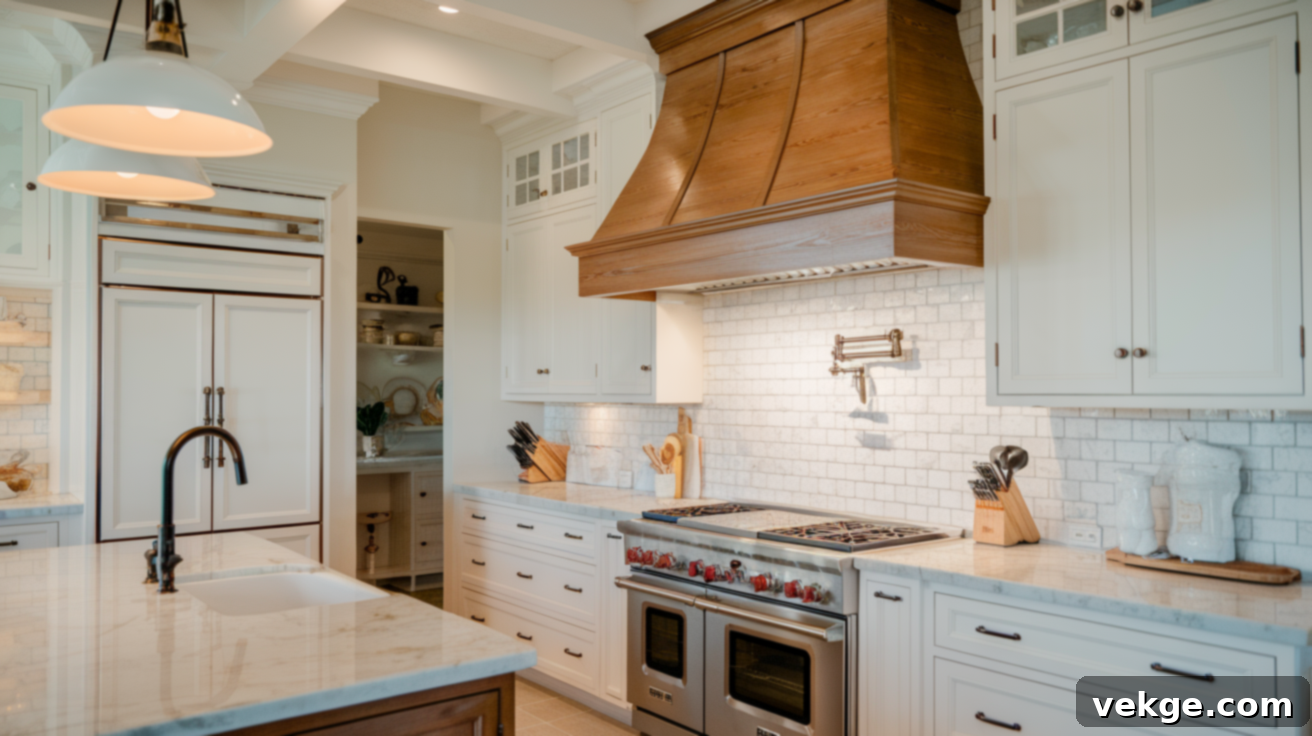Transform Your Kitchen: The Ultimate Guide to Range Hood Covers & Stylish Design Ideas
Kitchen range hood covers are more than just functional necessities; they are powerful design elements that can elevate the entire aesthetic of your cooking space. By seamlessly blending practical ventilation with captivating style, these covers transform an often-overlooked appliance into a stunning focal point. Whether you envision the rustic charm of a farmhouse kitchen or the sleek sophistication of a modern design, a well-chosen range hood cover can tie your entire kitchen together, enhancing its appeal and value.
These versatile covers work in harmony with your existing ventilation system, efficiently removing cooking smoke, steam, and odors. Simultaneously, they cleverly conceal the typically plain and industrial metal hood underneath, offering a myriad of material options such—from rich woods and polished metals to elegant stone and creatively repurposed items. The right range hood cover ensures optimal air quality while making a distinct style statement that truly uplifts the overall look of your kitchen.
Why Consider a Range Hood Cover? Blending Function and Form
Range hood covers offer a dual advantage in kitchen design: they fulfill essential ventilation needs while providing a unique opportunity for aesthetic customization. Functionally, they integrate with your existing exhaust system to efficiently draw smoke, steam, and cooking odors out of your kitchen, maintaining a fresh and comfortable environment. Visually, they transform the often utilitarian-looking metal hood into a striking decorative feature.
A thoughtfully designed cover skillfully hides the basic mechanics of your range hood, turning it into a beautiful centerpiece that reflects your personal style. As highlighted by Hartley Home Design, even a simple “slipcover” style hood can create a significant visual impact without requiring extensive renovations or high costs, making it an accessible upgrade for many homeowners.
Homeowners frequently opt for materials such as wood, metal, stone, or even unique repurposed items to craft their covers. Platforms like Becky Locke’s “vent hood covers” on Pinterest showcase how these additions can harmoniously integrate with your kitchen’s existing decor. Whether your preference leans towards the cozy allure of wooden farmhouse covers or the clean lines of a contemporary design, a range hood cover provides an opportunity to infuse your kitchen with character and elevate its overall design.
Key Considerations Before Installing a Range Hood Cover
Before embarking on the installation of a new range hood cover, several critical factors demand careful planning to ensure the best possible outcome for your kitchen’s functionality and design.
Size and Fit: Ensuring Perfect Integration
Accurate measurements are paramount for a successful range hood cover installation. Before purchasing or building, meticulously measure the width, height, and depth of your existing hood and the surrounding space. Covers are available in a wide range of widths, commonly spanning from under 30 inches to over 49.5 inches. Incorrect measurements can lead to poor ventilation performance, an awkward appearance, or costly adjustments. Consider not only the fit around the existing hood but also how the cover will proportionally relate to your stovetop and cabinetry.
Material Choices: Balancing Aesthetics and Durability
The material you select for your range hood cover significantly influences both its visual impact and its price point. Wood remains a popular choice, offering warmth and versatility with options from economical plywood to premium hardwoods like oak, maple, or walnut, which can be stained or painted to match any decor. Metal covers, including sleek stainless steel, rustic copper, or elegant black finishes, provide clean lines, excellent durability, and are generally easier to clean. For a touch of luxury, some homeowners opt for stone or marble, creating a dramatic and high-end aesthetic. Other creative options include plaster, drywall for a seamless look, or even reclaimed materials for a unique, eco-friendly statement. Each material offers distinct maintenance requirements and heat resistance properties that should be considered.
Ventilation Type: Ducted vs. Ductless
The type of ventilation system your kitchen uses—ducted (venting outside) or ductless (recirculating air)—will impact your cover’s design and installation. Ducted systems require careful planning for ductwork routing within or behind the cover, ensuring adequate space and proper sealing. Ductless systems, while simpler to install in terms of venting, still need to allow for proper air intake and exhaust, often with charcoal filters that need to be accessible for replacement. Ensure your chosen cover design is compatible with your specific ventilation mechanism.
Budget and Installation Complexity
Range hood cover projects can vary widely in cost and labor. DIY options using wood or plaster are generally more budget-friendly, typically requiring basic carpentry skills and a weekend. Custom-built covers from specialty manufacturers, especially those involving stone or unique metals, will naturally incur higher costs and necessitate professional installation due to their weight and intricate design. Factor in not just material costs, but also potential labor, specialized tools, and any necessary modifications to your existing kitchen structure.
Inspirational Range Hood Cover Ideas for Every Kitchen Style
Drawing inspiration from popular home improvement sites and Pinterest boards, here are some standout range hood cover styles that can dramatically enhance your kitchen’s aesthetic while maintaining essential ventilation.
1. Farmhouse Style Range Hood Cover
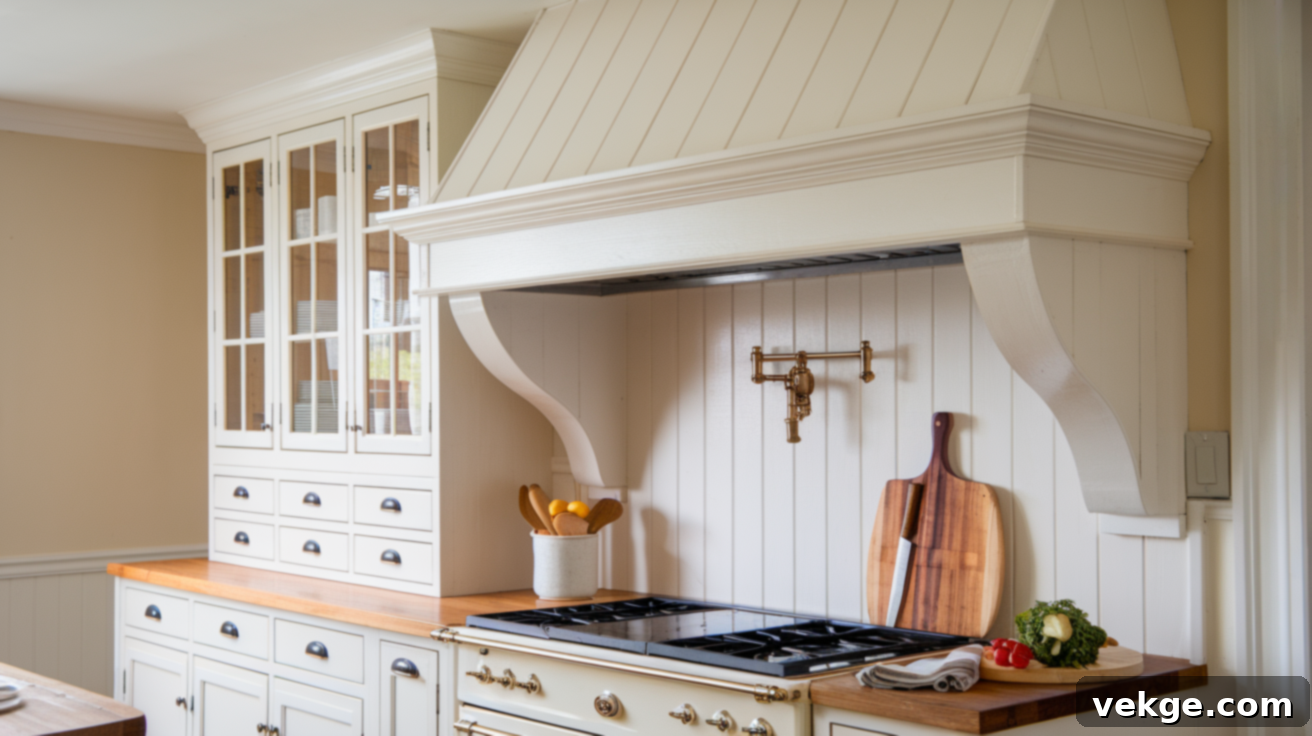
Embrace the cozy, rustic charm with a farmhouse-style range hood cover. Typically crafted from wood panels, often painted white or cream, this style imparts a warm, lived-in feel to your kitchen. To enhance its character, consider adding simple trim work, crossbeams, or a distressed finish. This design perfectly complements country-themed kitchens featuring open shelving, natural wood elements, and vintage-inspired decor. Pinterest boards, such as Paula Gianopoulos’s, offer numerous examples showcasing elegant simplicity with crown molding and subtle board details.
2. Modern Minimalist Range Hood Cover
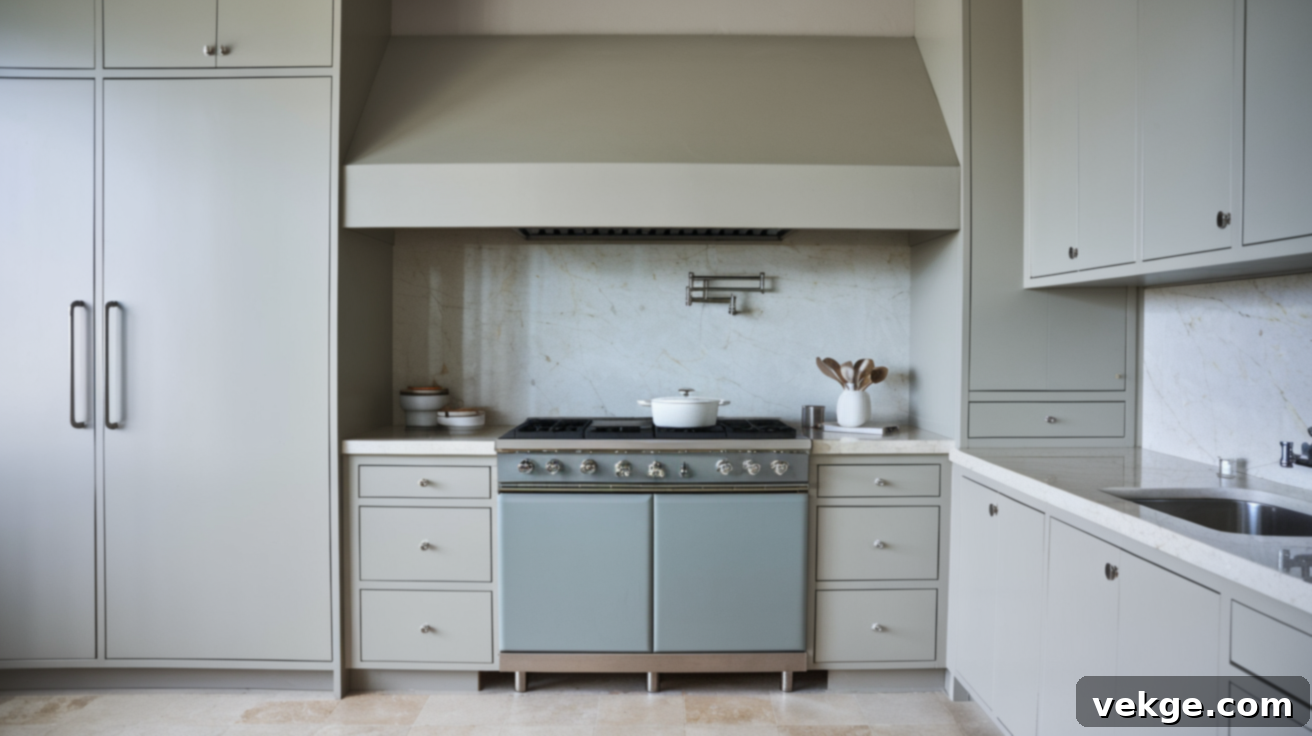
Defined by clean lines, flat surfaces, and an understated elegance, the modern minimalist range hood cover seamlessly integrates into contemporary kitchen designs. Often painted to match surrounding cabinetry, these covers create a cohesive and unbroken visual flow. They typically feature hidden seams and hardware, maintaining a smooth, uncluttered appearance. Family Handyman showcases examples where simple, geometric shapes make a powerful statement without overwhelming the space, embodying the “less is more” philosophy.
3. Custom Copper Range Hood Cover
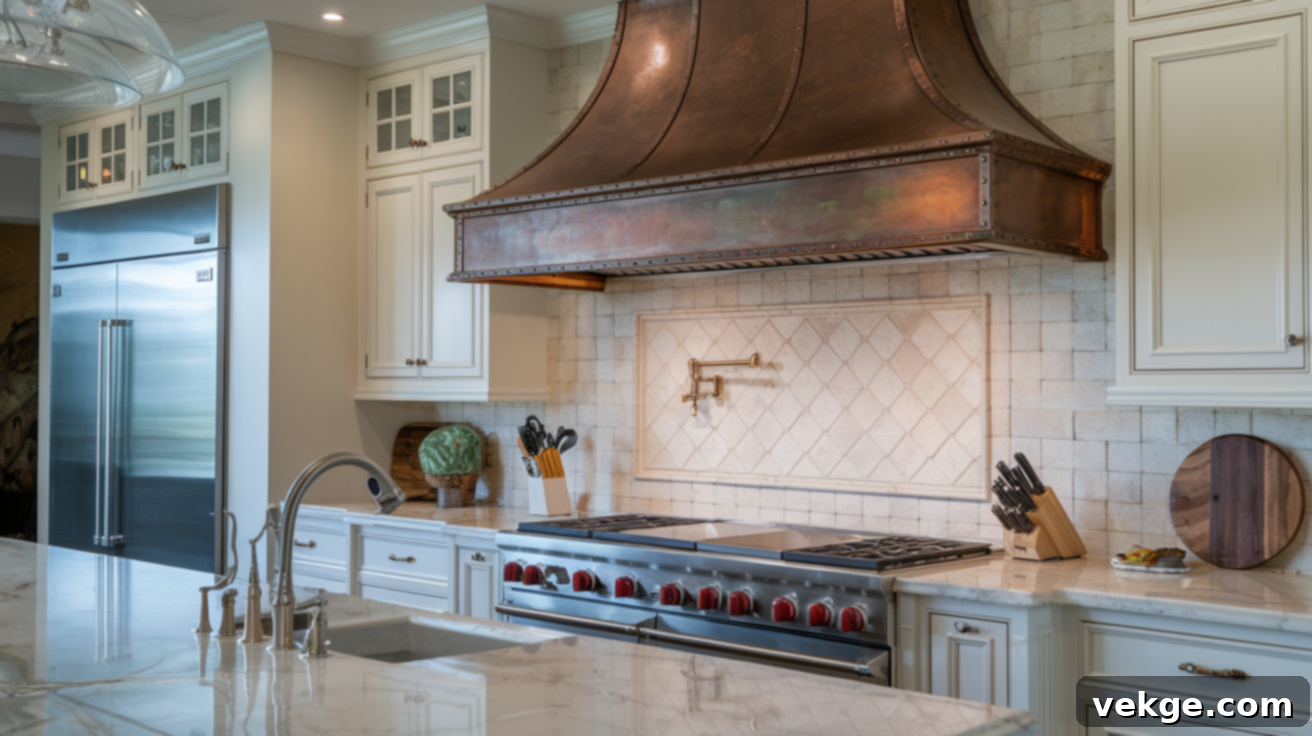
For a touch of luxury and unique character, a custom copper range hood cover is an excellent choice. These eye-catching covers develop a distinctive patina over time, adding depth and a rich, warm glow to any kitchen color scheme. While often a more significant investment, the search results clearly indicate that copper hoods frequently become the stunning centerpiece of kitchen designs, pairing beautifully with neutral-colored cabinets and natural stone countertops. Their timeless appeal and natural beauty make them a cherished element.
4. Wooden Shaker-Style Range Hood Cover
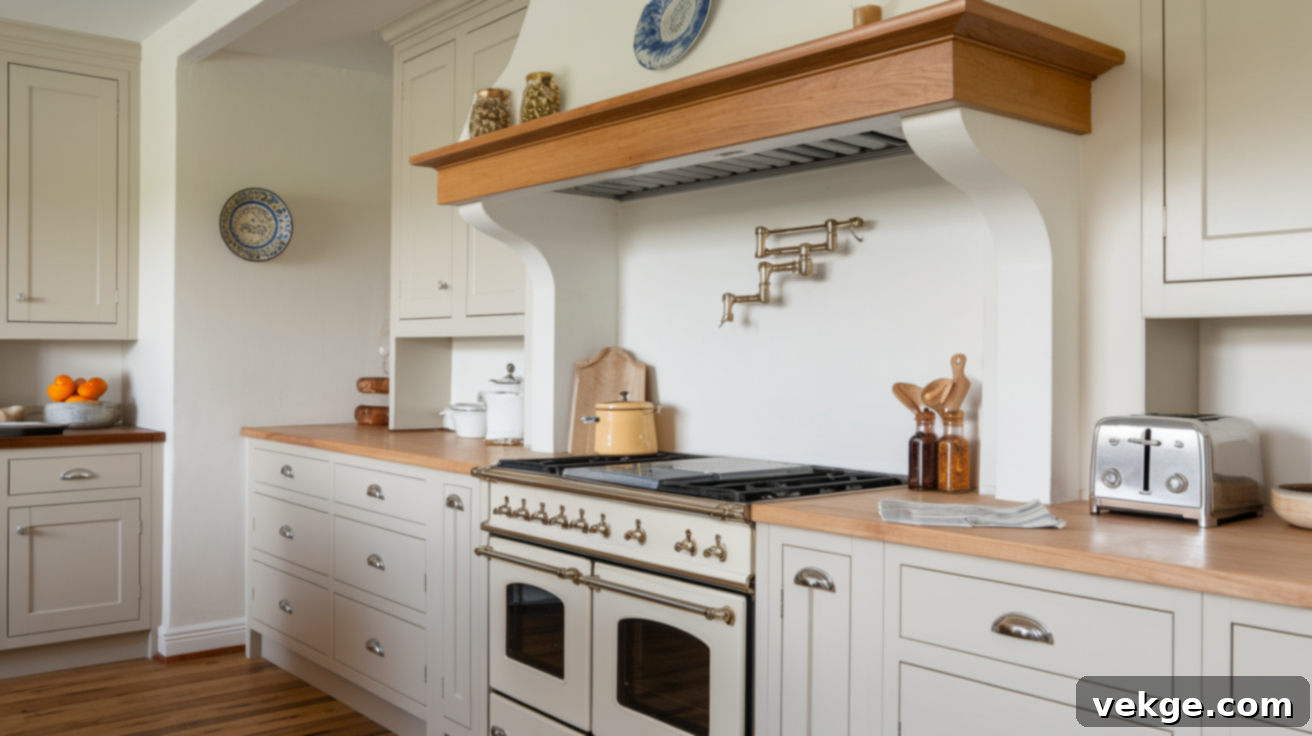
The classic frame-and-panel construction of a wooden Shaker-style range hood cover ensures a timeless and versatile design. Its clean, simple lines make it adaptable to a wide array of kitchen styles, from traditional to transitional and even slightly modern aesthetics. Often painted in crisp white or soft gray to complement existing cabinetry, these covers typically feature straightforward crown molding and straight edges, embodying a design that never goes out of style and offers enduring elegance.
5. Custom Tile Range Hood Cover
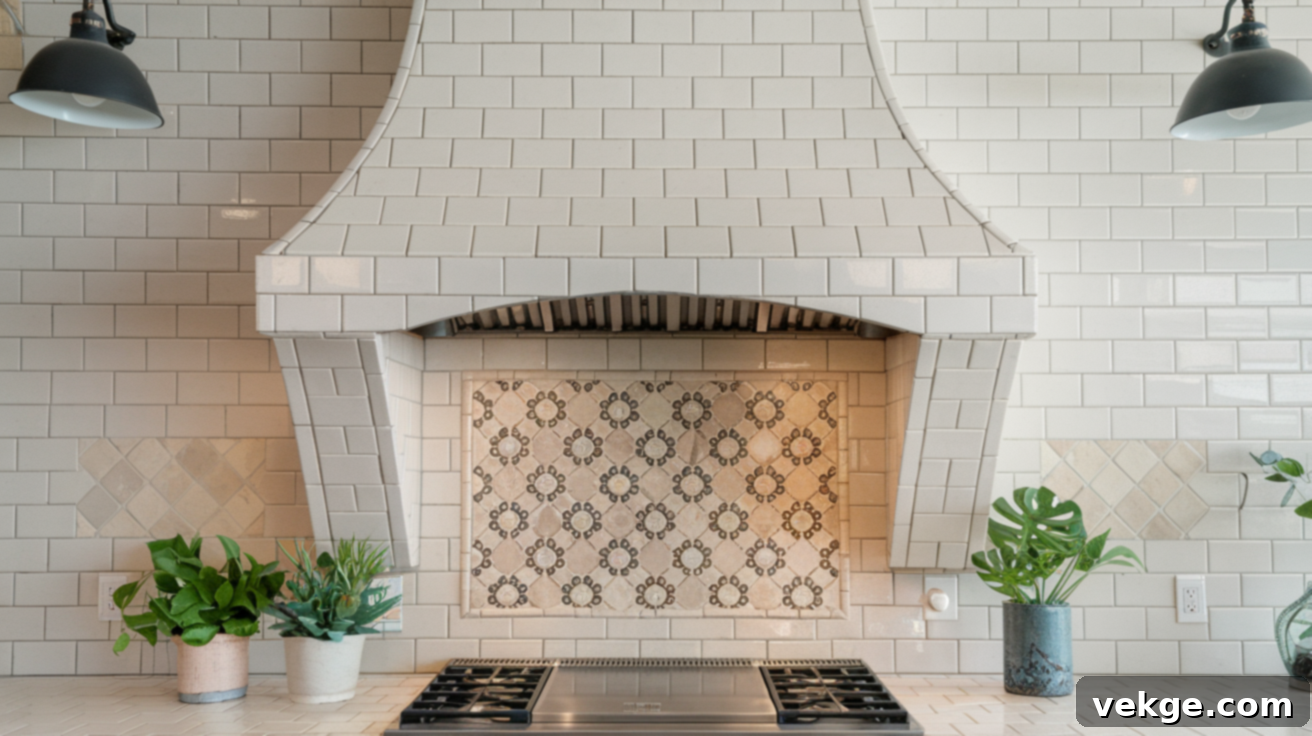
A custom tile range hood cover allows for creative expression and seamless integration. Whether using classic subway tiles, intricate mosaic patterns, or extending your existing backsplash material, tile creates a beautifully cohesive and finished look. For an optimal visual flow, the tile can gracefully transition from the backsplash directly up and over the hood. House Beautiful frequently features hoods where the tile work becomes an integral part of the overall kitchen narrative, rather than a separate element, fostering a harmonized design.
6. Industrial Metal Range Hood Cover
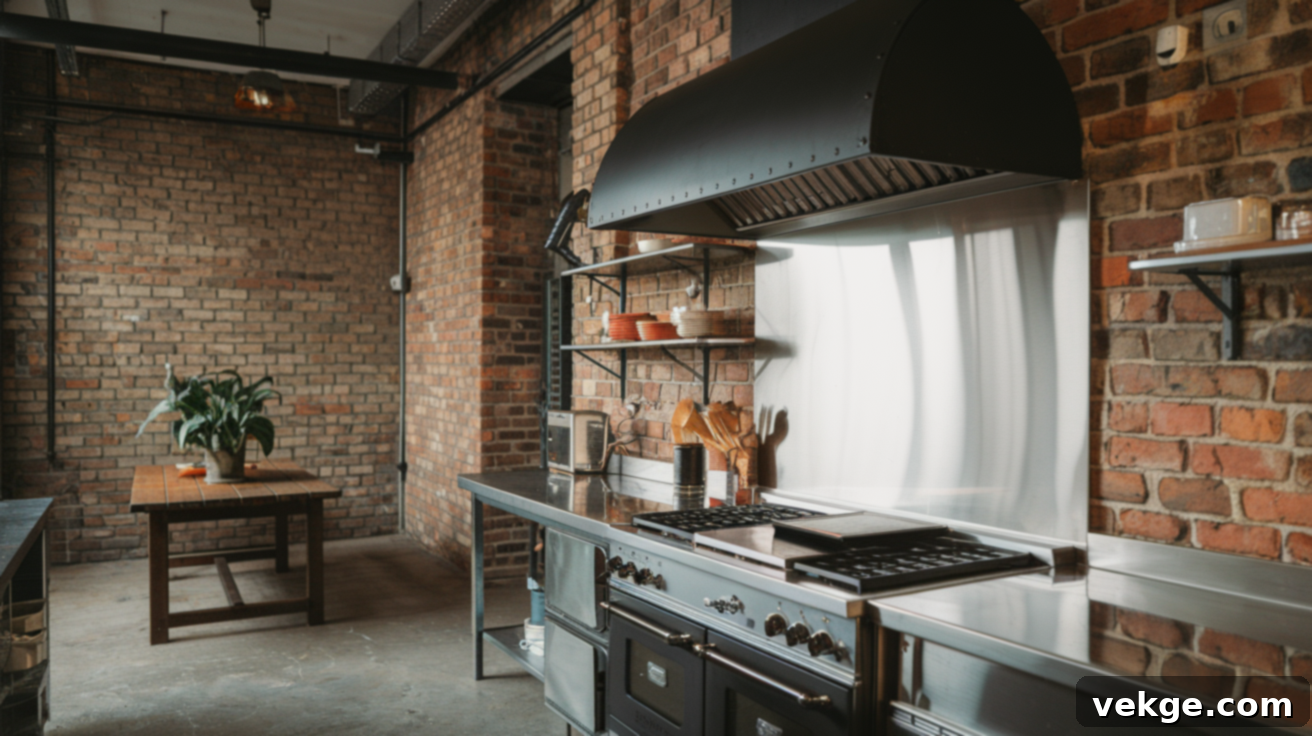
For an edgy, urban appeal, an industrial metal range hood cover is an ideal choice. Featuring black matte finishes or brushed stainless steel, these covers often showcase simple shapes with visible seams and hardware, deliberately embracing a factory-inspired aesthetic. These low-maintenance covers perfectly suit lofts, modern apartments, and kitchens that incorporate other concrete or metal features, creating a cohesive and ruggedly stylish environment.
7. Retro Range Hood Cover
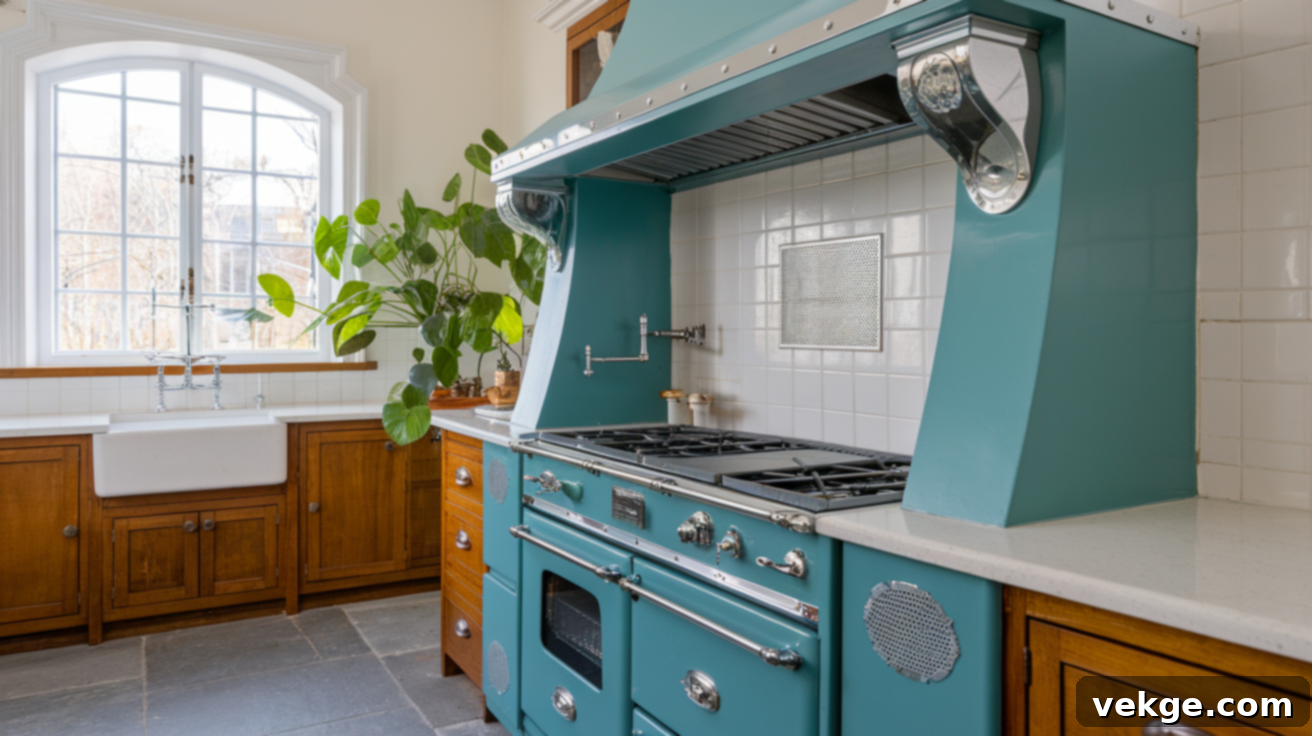
Inject fun and personality into your kitchen with a retro range hood cover. Characterized by vibrant colors like teal, sunny yellow, or bold red, and complemented by curved edges and gleaming chrome accents, this style perfectly captures a mid-century feel. These playful covers thrive in kitchens that celebrate vintage appliances, bold color palettes, and a general sense of nostalgia, making cooking spaces feel cheerful, inviting, and full of life.
8. Marble Range Hood Cover
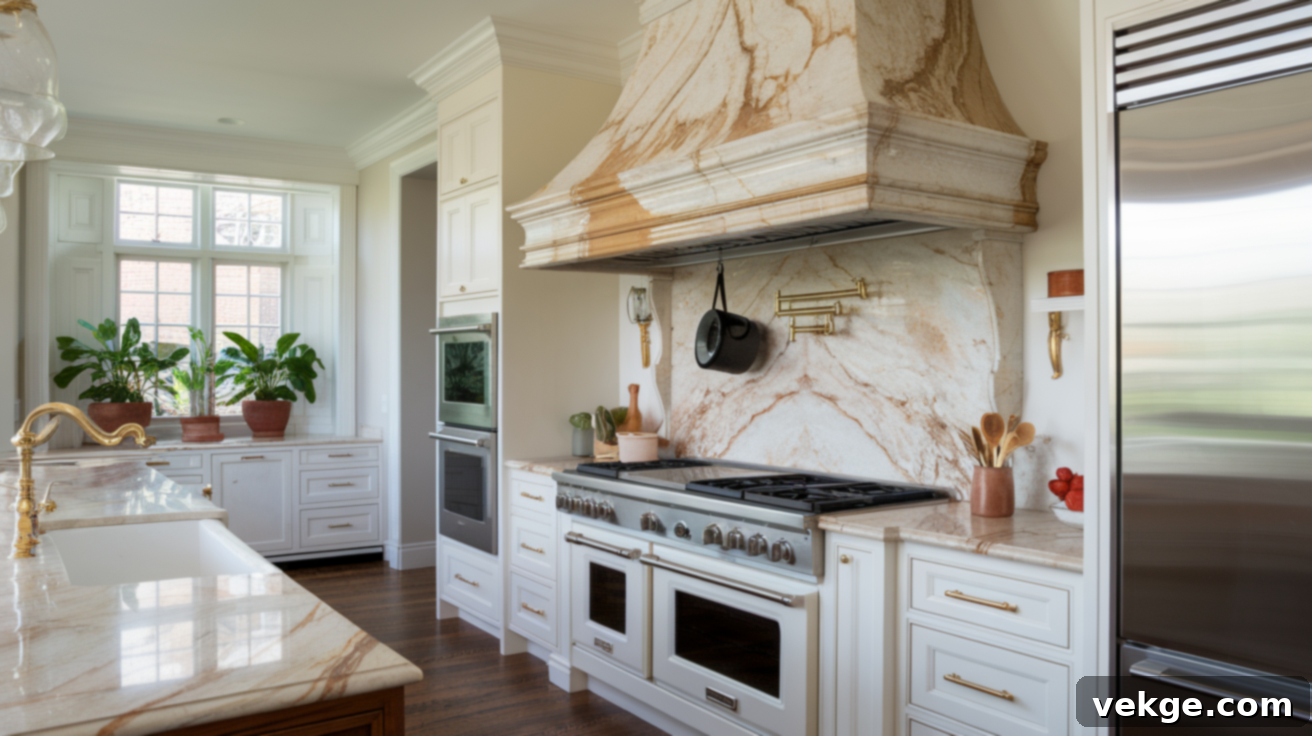
A marble range hood cover instantly brings an undeniable sense of luxury and sophistication to any kitchen space. The unique natural stone patterns ensure that each cover is one-of-a-kind, adding an unparalleled touch of class and grandeur. Many designers strategically use marble that mirrors island countertops or backsplashes to create a harmonious and flowing design throughout the kitchen. This high-end option beautifully complements both classic and ultra-modern kitchen settings, serving as a magnificent focal point.
9. Fluted Wood Range Hood Cover
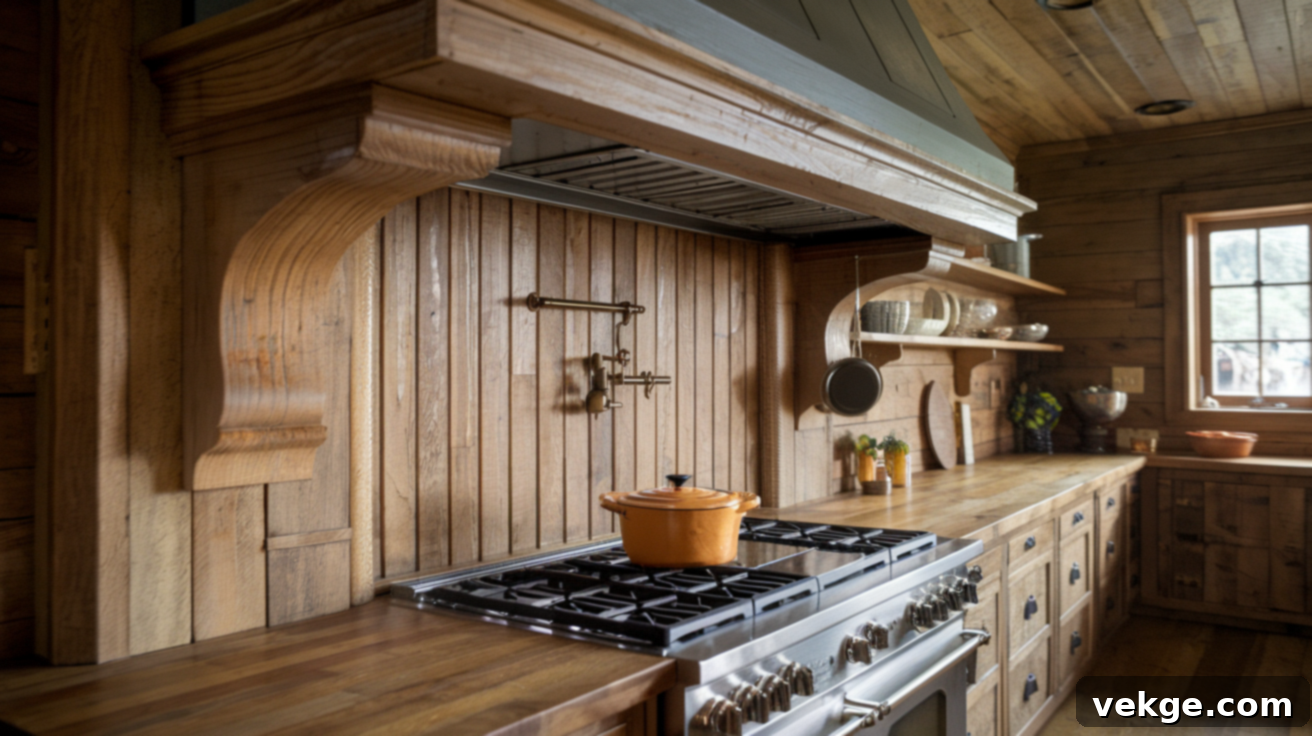
Vertical grooves, or “fluting,” add remarkable depth and visual interest to wooden range hood covers. This elegant style has surged in popularity recently, with instructional content like Kayla Simone’s YouTube channel demonstrating the complete build process (check it out here: Building A Custom Fluted Range Hood Cover). The textured surface beautifully catches light in varying ways throughout the day, creating subtle shifts and a sense of dynamic movement in the kitchen, even when culinary activities are paused.
10. Glass Range Hood Cover

For a light and airy aesthetic, a glass range hood cover offers a contemporary and refined solution. These covers allow the underlying hood mechanics to subtly show through while maintaining a polished and sophisticated appearance. Frosted glass options can provide a soft, diffused glow when the under-hood lighting is in use, adding to the ambiance. While less common in traditional designs, glass covers are particularly effective in making smaller kitchens feel more open, expansive, and less visually cluttered by heavy overhead fixtures.
11. French Country Range Hood Cover
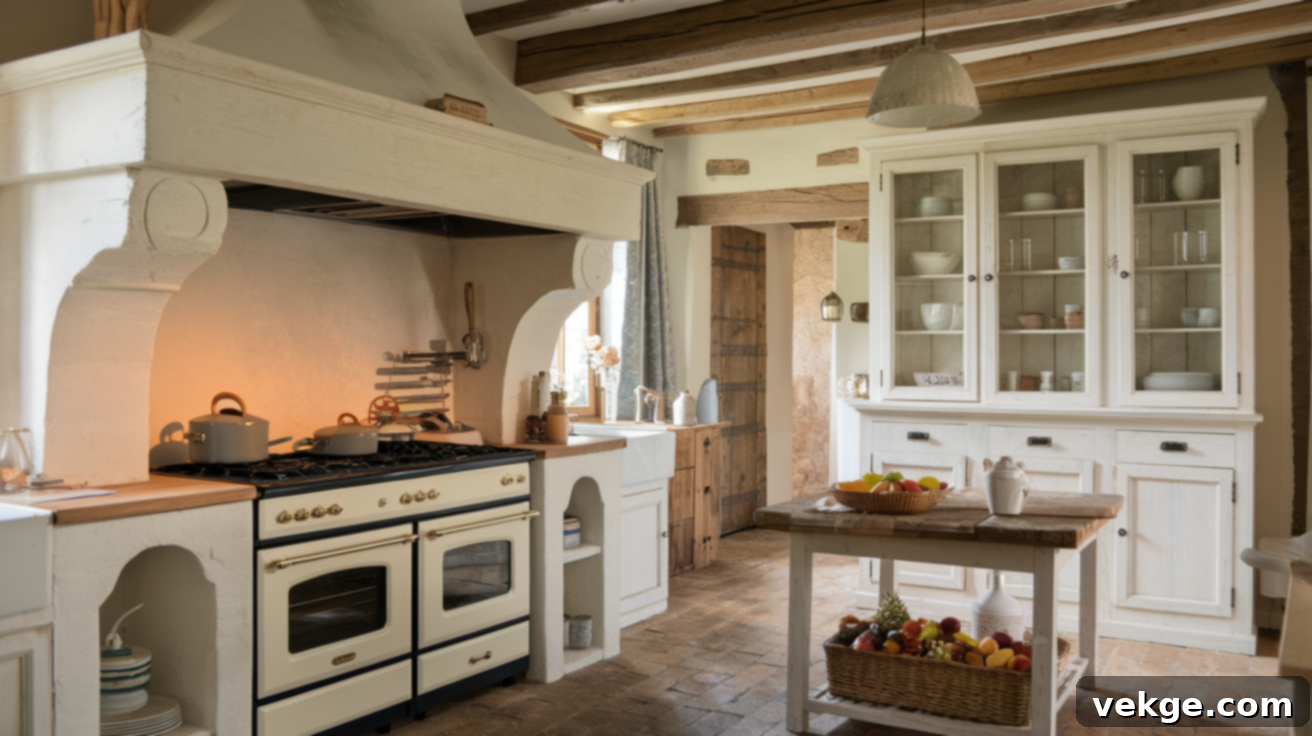
Defined by soft curves, gentle arches, and an understated elegance, the French Country range hood cover evokes a charming, provincial feel. Often finished in creamy whites or soft pastels with subtle distressing, these covers might incorporate delicate decorative touches such as carved details or nuanced paint effects. They are instrumental in creating a warm, inviting, and intimate atmosphere that establishes the kitchen as the true heart of the home, imbued with rustic sophistication.
12. Stainless Steel Range Hood Cover

A perennial favorite, the stainless steel range hood cover is both practical and timeless. Renowned for its heat resistance and ease of cleaning, it’s a highly functional choice for any busy kitchen. Stainless steel reflects light, brightening the cooking area, and its universal appeal allows it to seamlessly match most modern appliances and kitchen finishes. Retailers like Home Depot offer various options, making this one of the most budget-friendly yet polished-looking choices for contemporary kitchen updates, ensuring both durability and a sleek aesthetic.
13. Shabby Chic Range Hood Cover
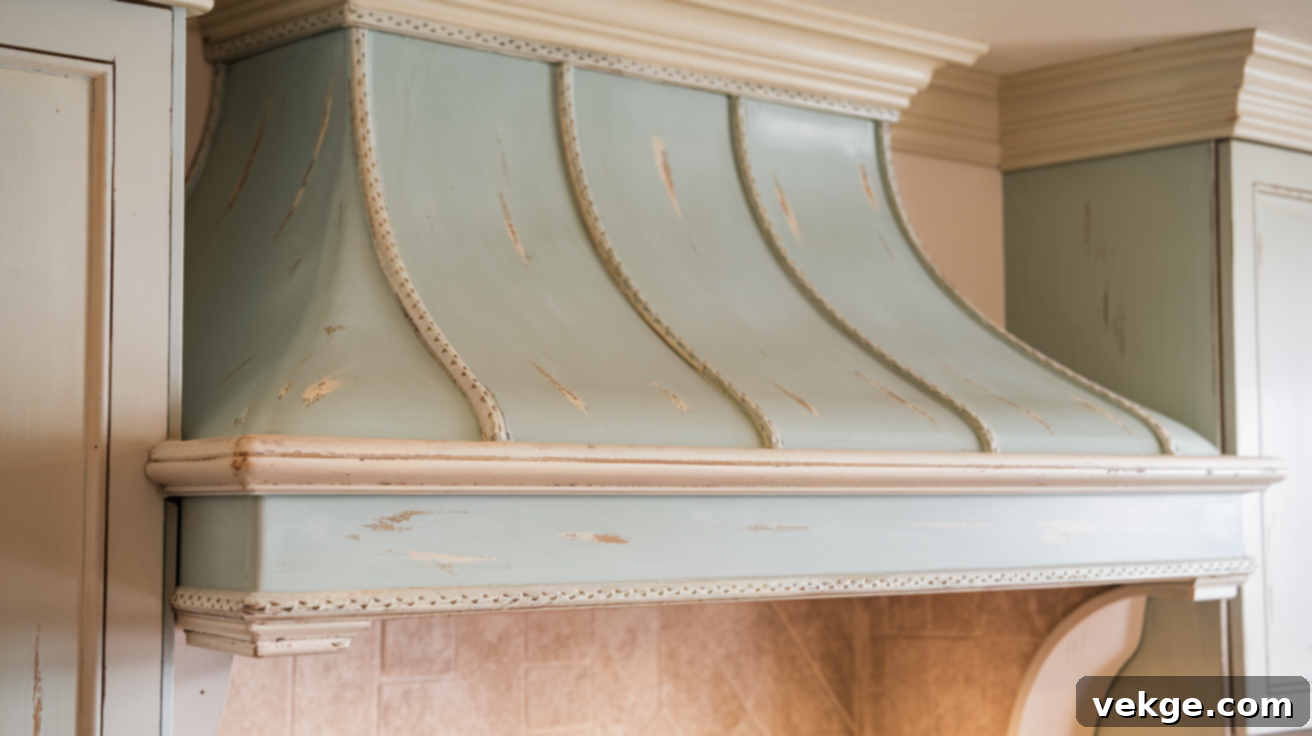
Embrace a charming, lived-in aesthetic with a shabby chic range hood cover. Typically painted in soft, muted colors with carefully applied distressing, these covers exude a comfortable, antique-inspired appeal. They often feature simple trim work and might include delicate decorative touches or subtle carvings. This style contributes to the feeling that the kitchen has evolved organically over time, possessing a history and character rather than appearing newly installed, creating a wonderfully relaxed and inviting ambiance.
14. Farmhouse Wood and Metal Range Hood Cover

This popular blend combines the inherent warmth of natural wood with the stark contrast of metal strapping or trim, creating a balanced and visually engaging look. The harmonious mix of materials adds significant visual interest while firmly anchoring the design in farmhouse roots. Pinterest boards are rich with examples where dark metal details, such as iron bands or rivets, strikingly pop against lighter wood backdrops, forming eye-catching focal points that celebrate both rustic and industrial elements.
15. Vintage Tin Range Hood Cover
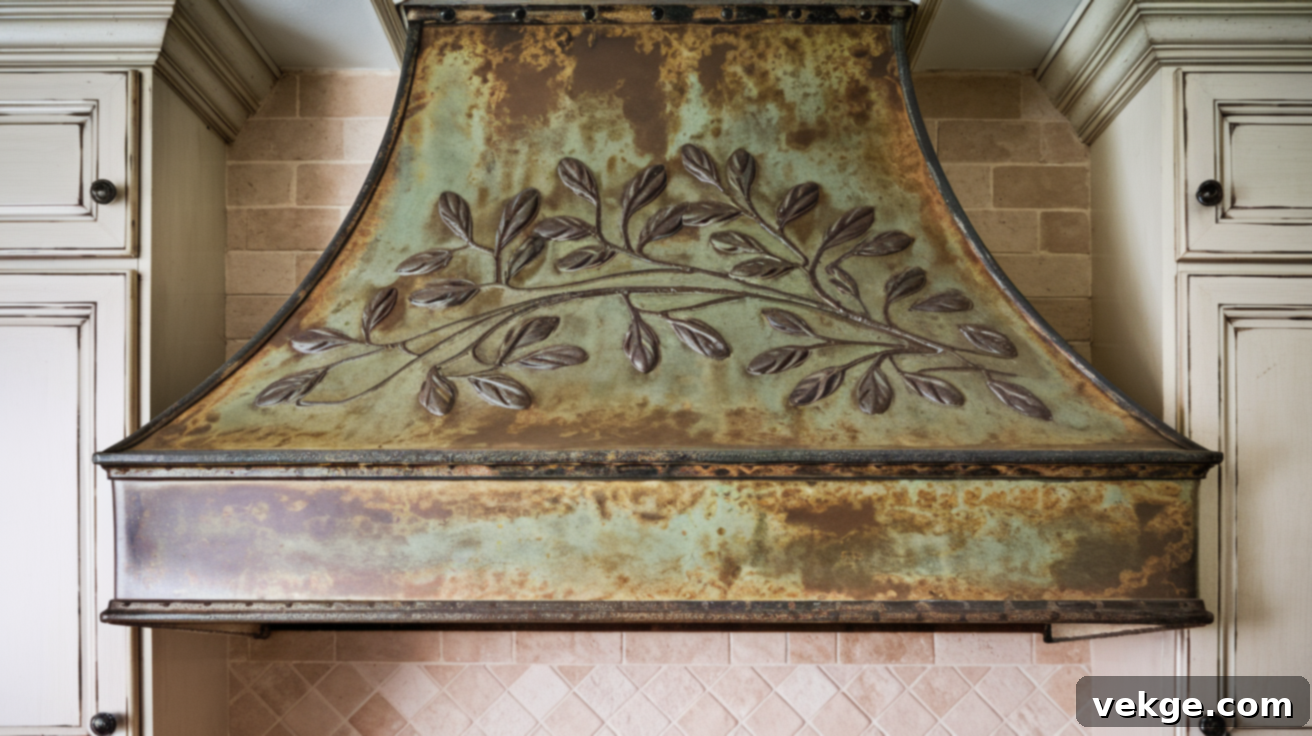
For a unique touch of history and intricate texture, consider a vintage tin range hood cover. This style often incorporates repurposed antique ceiling tin or new pressed metal with classic patterns. The embossed designs beautifully catch the light, creating interesting shadows and highlights that add significant character and a bygone-era charm to your kitchen. It’s a fantastic way to introduce architectural detail and a personalized, artistic flair.
16. Painted Range Hood Cover
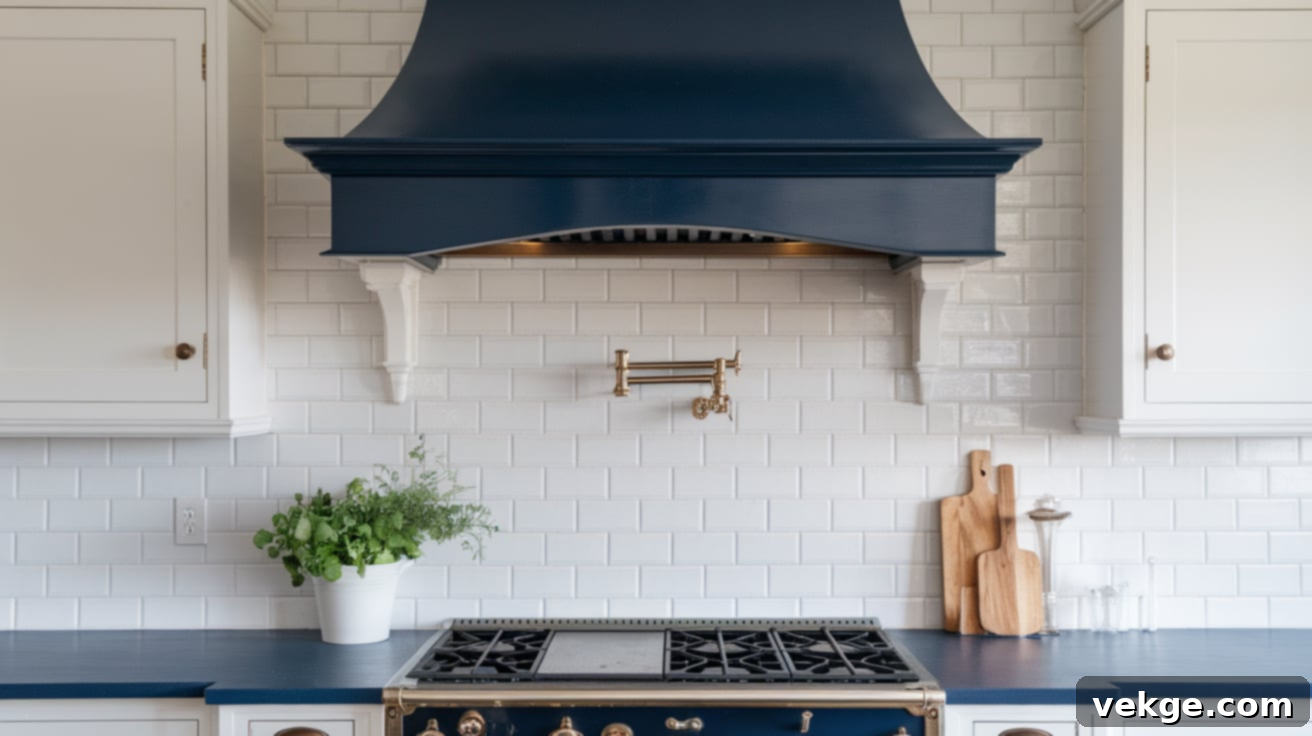
A painted range hood cover offers unparalleled flexibility in kitchen design, allowing you to either make it a prominent feature or have it seamlessly blend into your existing decor. You can choose to match your cabinet colors for a smooth, integrated look, or opt for a contrasting shade to create a bold and dynamic focal point. From soft, ethereal whites to deep, dramatic navy blues, a painted cover provides endless options to refresh and personalize your kitchen’s appearance without the need for extensive renovations. It’s a simple yet powerful way to introduce color and mood.
17. Herringbone Patterned Range Hood Cover
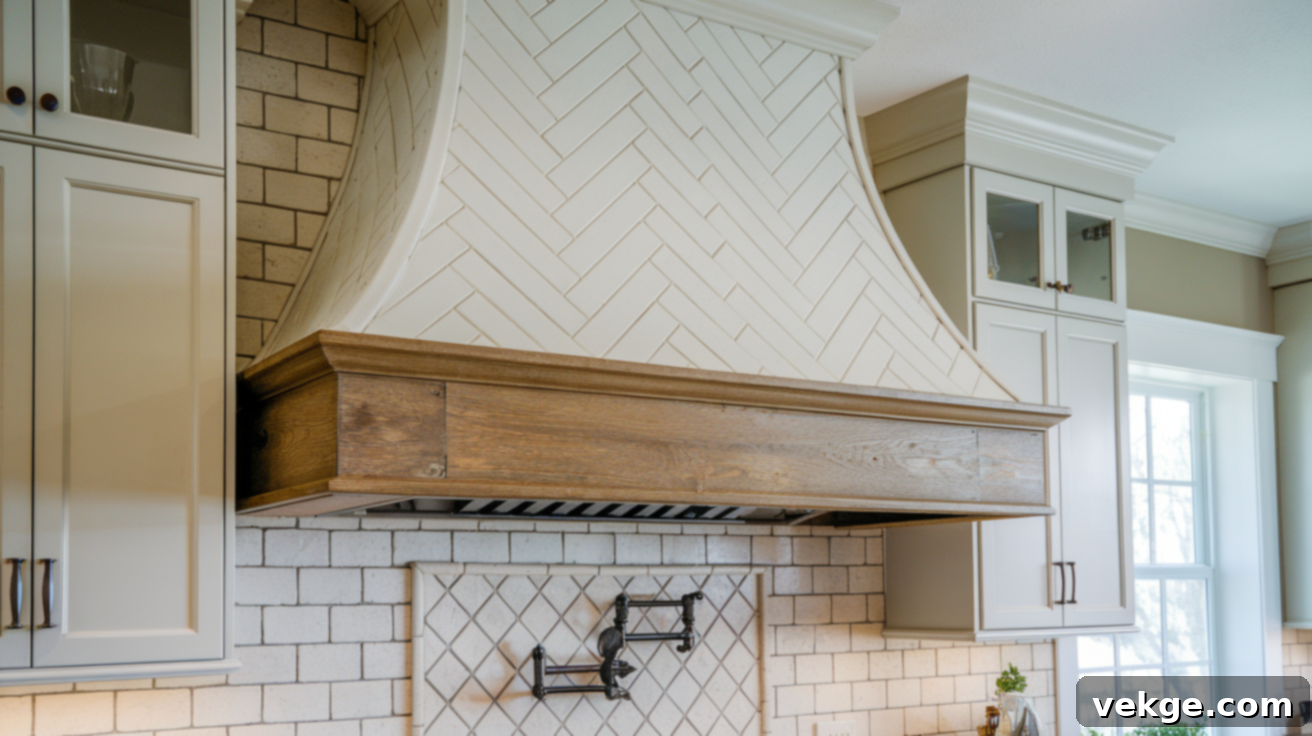
The distinctive zigzag layout of wood or metal pieces in a herringbone pattern creates striking visual movement and impressive depth. This intricately detailed pattern adds a sophisticated touch, working equally well in both expansive and more compact kitchens. The angled pieces are particularly adept at catching light differently throughout the day, giving your hood cover a subtly shifting appearance as ambient lighting changes, adding an element of dynamic elegance.
18. Custom Fluted Range Hood Cover
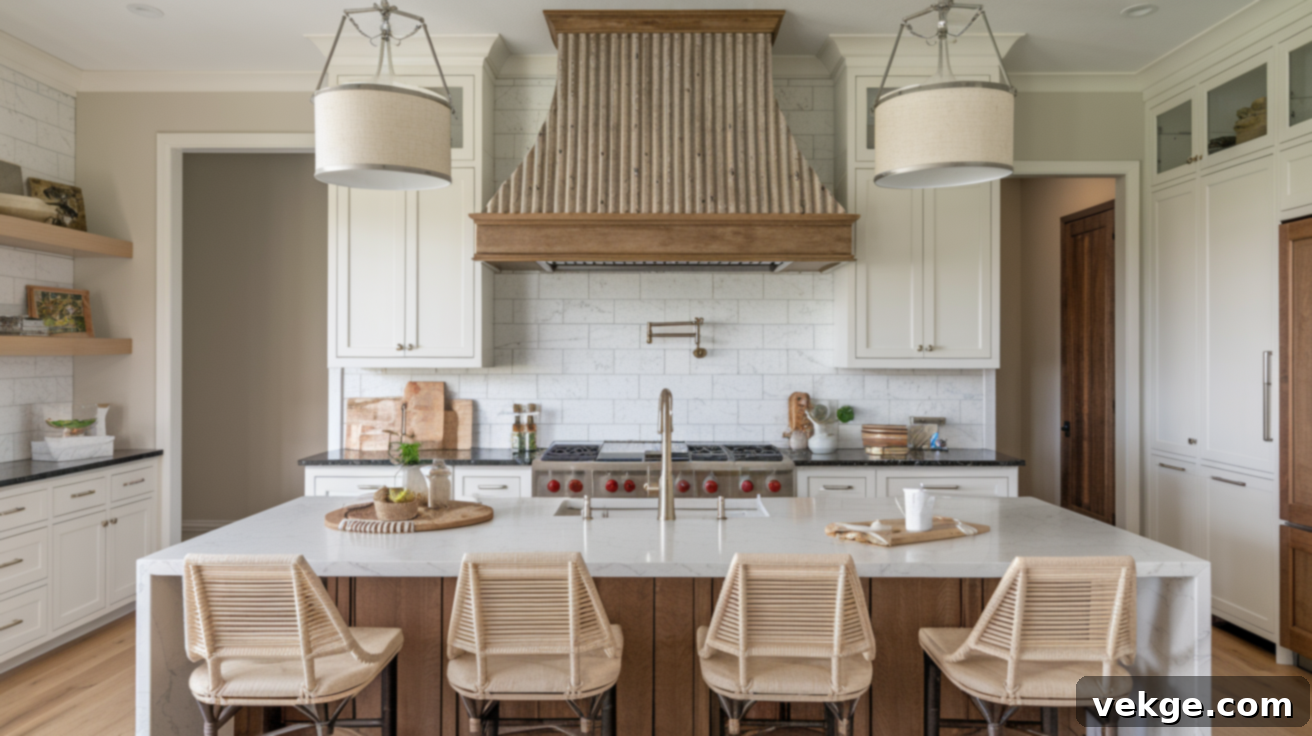
Vertical grooves precisely cut into wood panels define the custom fluted range hood cover, adding elegant shadows and rich texture to this kitchen feature. As showcased in popular DIY videos, such as those by Kayla Simone on YouTube, this sophisticated style has recently enjoyed a surge in popularity among homeowners and designers. The repeating vertical lines naturally draw the eye upward, creating an illusion of higher ceilings and imparting a refined, architectural touch to the cooking area, making it feel grander and more polished.
19. Stone Range Hood Cover
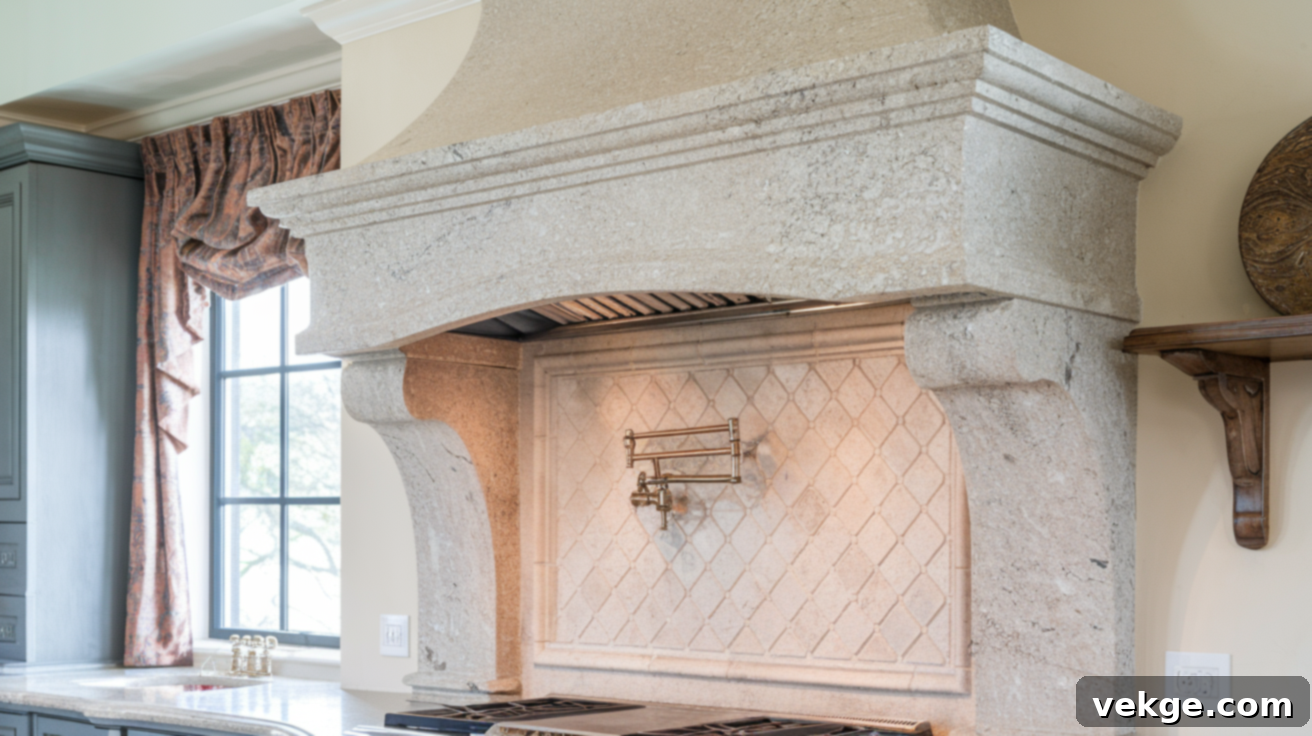
Utilizing natural stone like rugged granite, elegant slate, or luxurious quartz creates a solid, enduring impression for a range hood cover. These heavy-duty covers are particularly effective in kitchens that already feature other stone elements, such as countertops or backsplashes, establishing a harmonious and sophisticated material palette. Though their weight typically necessitates professional installation, the lasting beauty, exceptional durability, and inherent heat resistance of stone make them a worthwhile and stunning investment for a truly upscale kitchen.
20. Bamboo Range Hood Cover
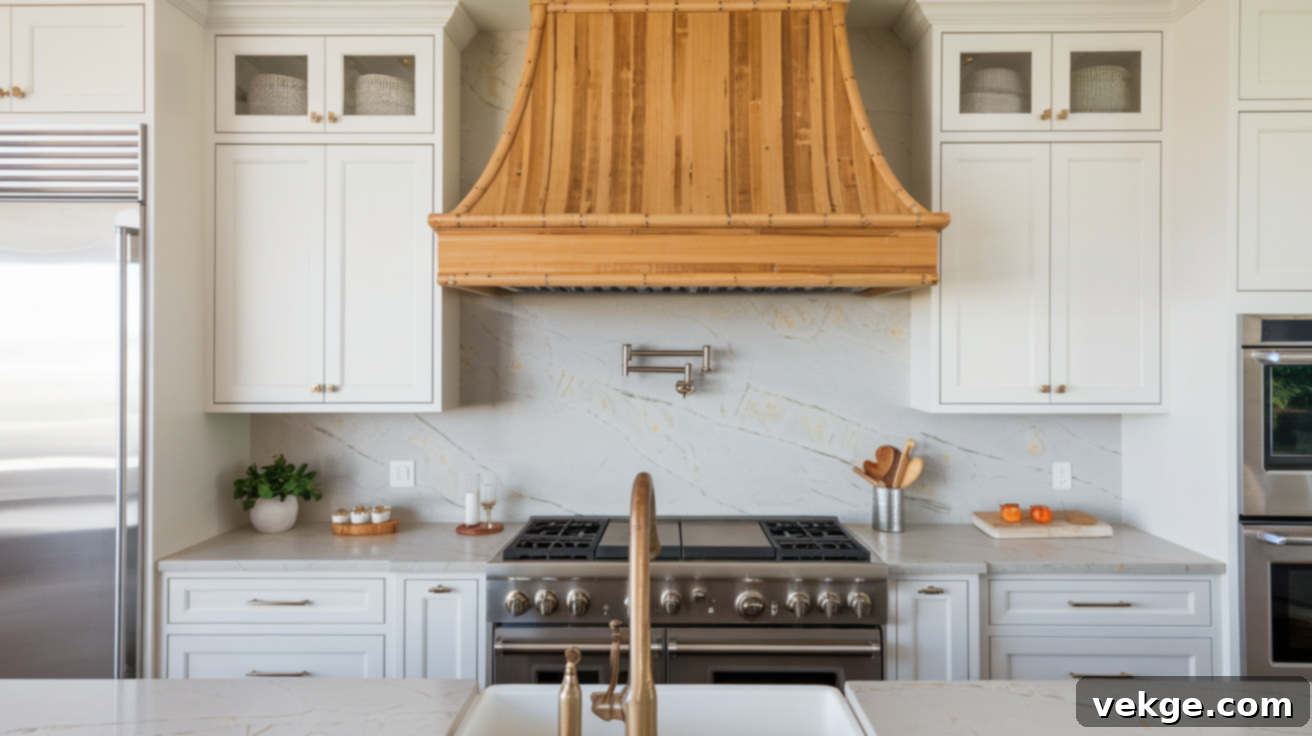
Embrace sustainable style with a bamboo range hood cover. This rapidly renewable material offers a naturally light color palette and distinct grain patterns, bringing a serene, organic warmth to your kitchen. More environmentally friendly than many traditional hardwoods, bamboo still delivers excellent durability and undeniable natural beauty. Its light hue integrates beautifully into both modern minimalist and more naturalistic kitchen designs, pairing exquisitely with indoor plants and other organic elements to create a calming and earthy atmosphere.
21. Industrial Chic Range Hood Cover

Raw materials and an unrefined aesthetic define the industrial chic range hood cover, cultivating an honest, workshop-inspired feel. These designs often intentionally expose structural elements like screws, bolts, and seams, celebrating them as integral parts of the design rather than concealing them. The compelling mix of textures – perhaps unfinished wood juxtaposed with bare metal – adds significant visual interest while maintaining a straightforward, no-nonsense approach to kitchen design, perfect for urban or loft-style spaces.
22. Glass and Wood Combination Range Hood Cover
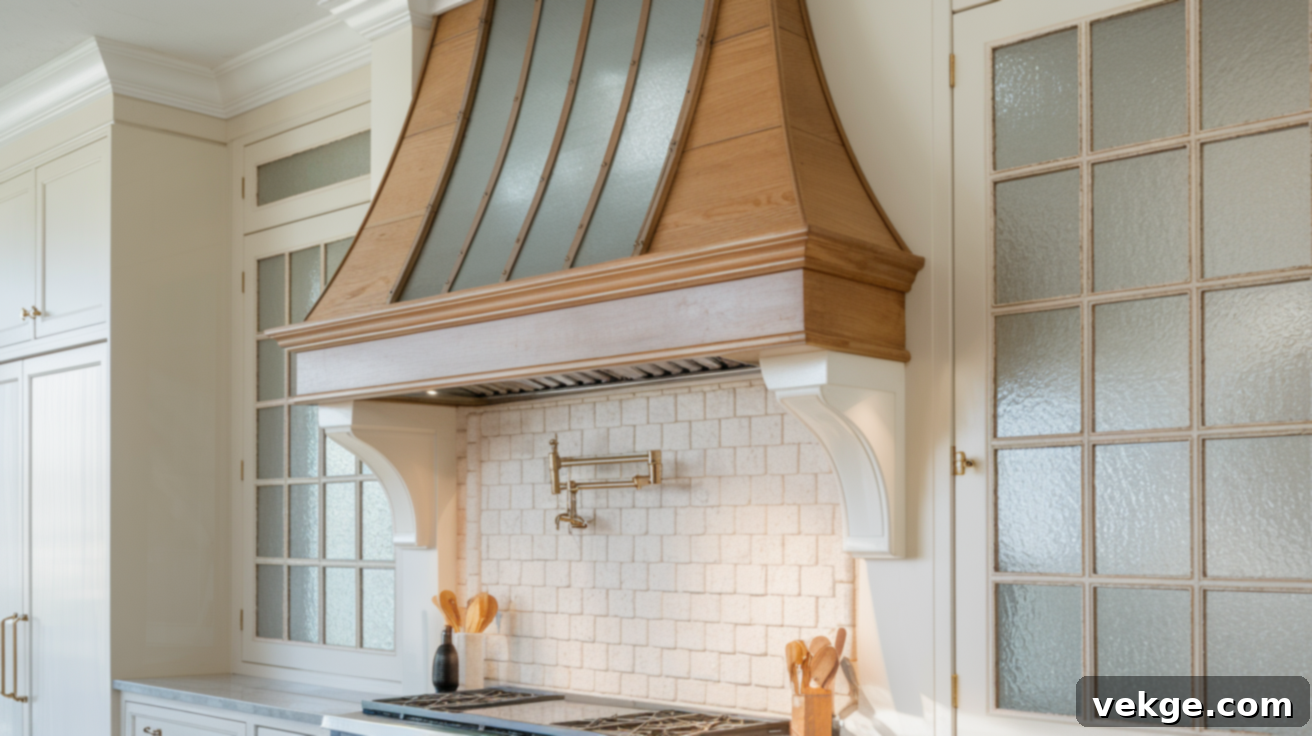
This sophisticated blend thoughtfully pairs the inherent warmth and natural appeal of wood frames with the lightness and transparency of glass panels. The combination creates a notably airier feel compared to solid all-wood options, while still incorporating organic elements. This style is particularly effective in kitchens with limited natural light, as the glass helps to enhance the sense of openness and prevents the space from feeling heavy or crowded, making it appear brighter and more spacious.
23. Contemporary Concrete Range Hood Cover
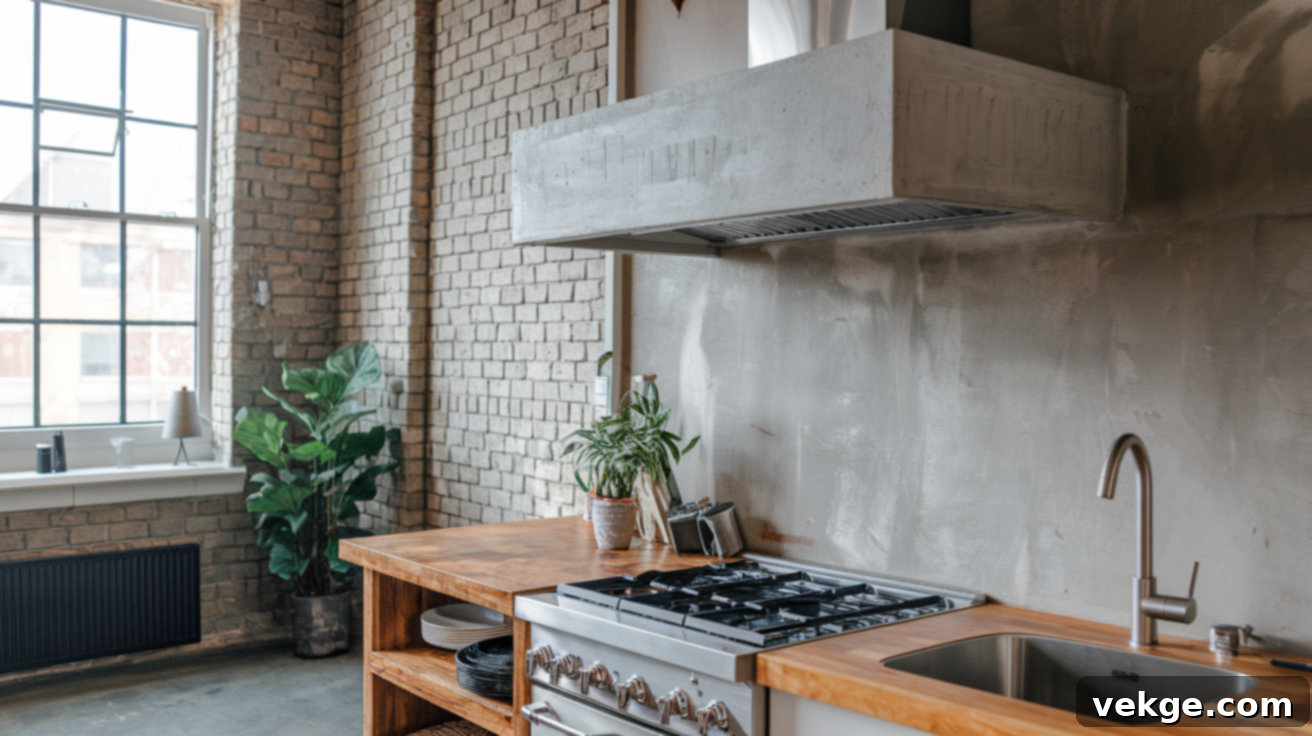
Offering a distinctly modern and urban aesthetic, contemporary concrete range hood covers can be either smooth and polished or feature a subtle texture. These sleek covers pair exceptionally well with other industrial fixtures, minimalist design schemes, and clean-lined cabinetry. While traditional concrete is heavy, advancements in modern concrete mixes allow for thinner and lighter applications, making this durable and uniquely styled option more accessible for today’s homes that seek a raw yet refined look.
24. Upholstered Range Hood Cover: Unique and Cozy
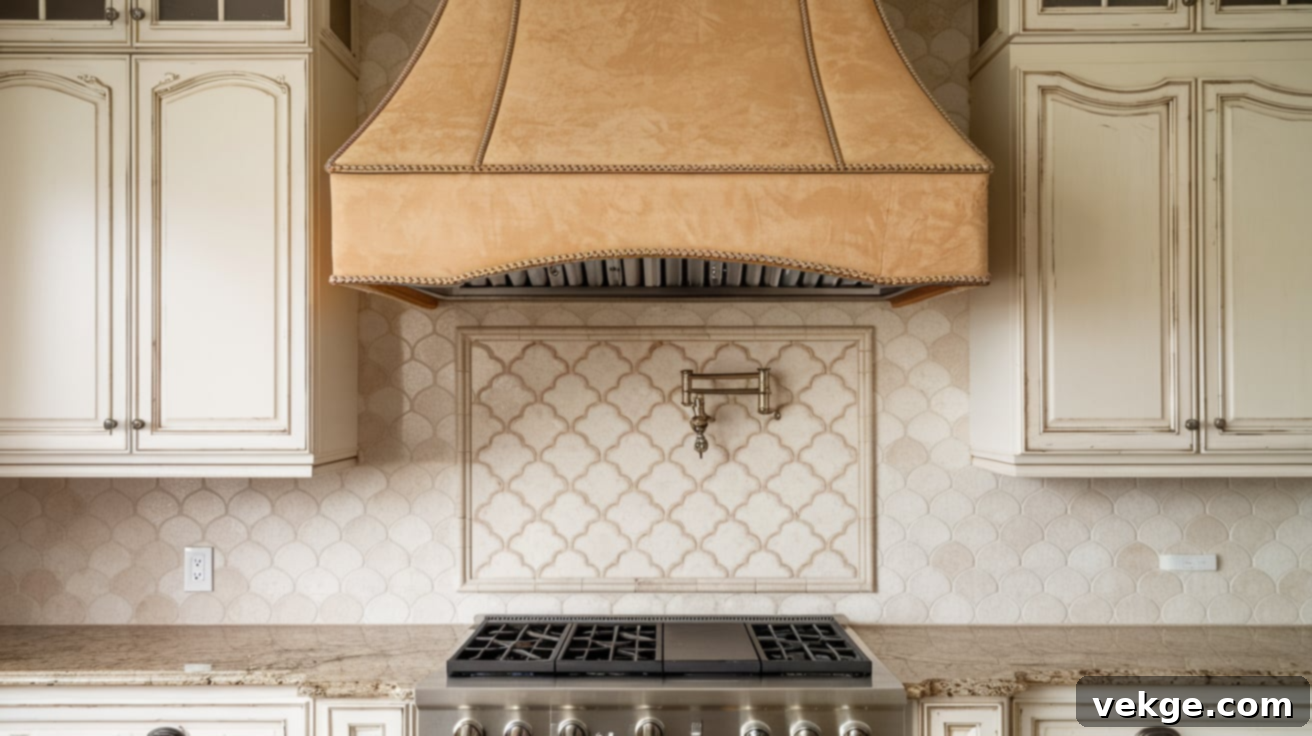
For a truly unexpected and luxurious touch, an upholstered range hood cover introduces comfort and warmth into the kitchen. By applying stain-resistant fabrics over a sturdy wooden frame, these covers cleverly soften the typically hard surfaces found in a kitchen environment. While not a common mainstream design, creative homeowners have successfully utilized this method to infuse their cooking spaces with vibrant color, intriguing texture, and a unique, inviting softness that sets their kitchen apart.
25. Arched Range Hood Cover
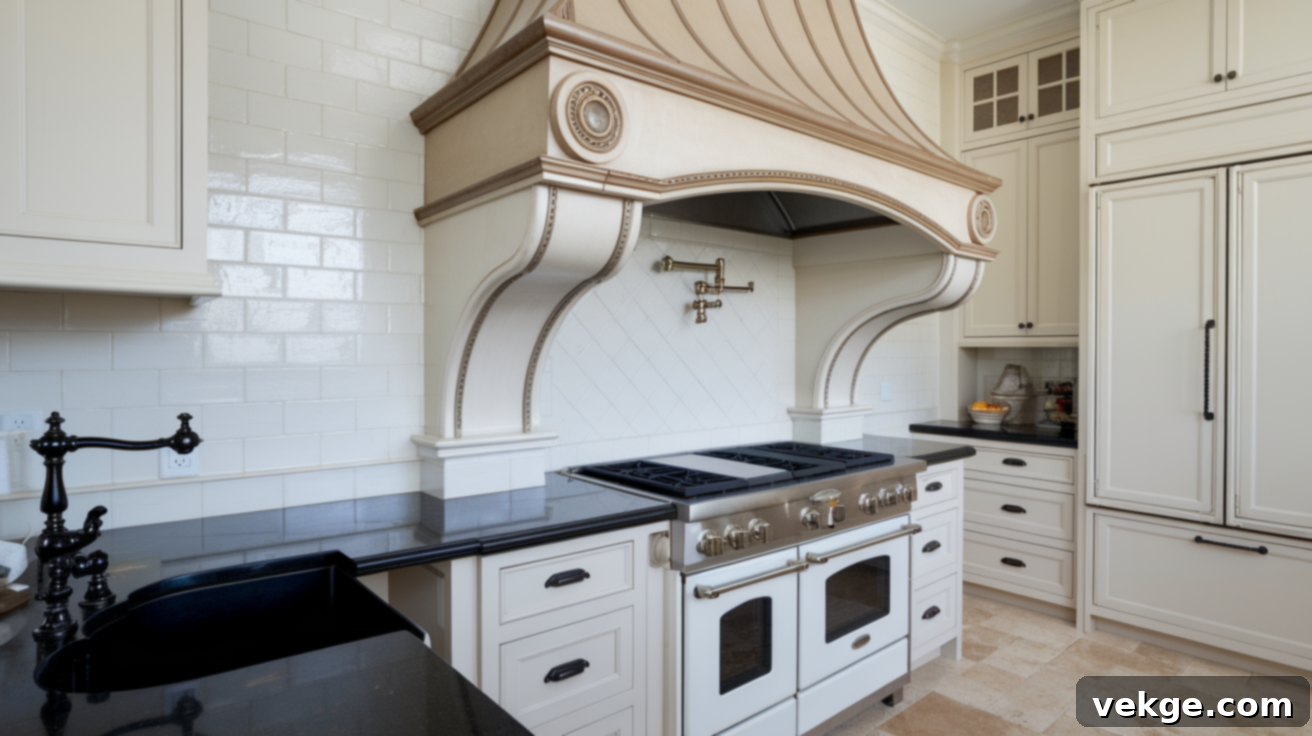
The gentle, graceful curve at the top of an arched range hood cover softens the overall feel of the kitchen, adding a touch of classic elegance. This timeless shape is versatile, fitting beautifully into both traditional and modern settings by introducing an element of architectural grace. Proline Range Hoods showcases several inspiring examples where the arch becomes a dominant design feature, drawing the eye upward and creating an illusion of taller ceilings and a more expansive space.
26. Hood Cover with Decorative Molding
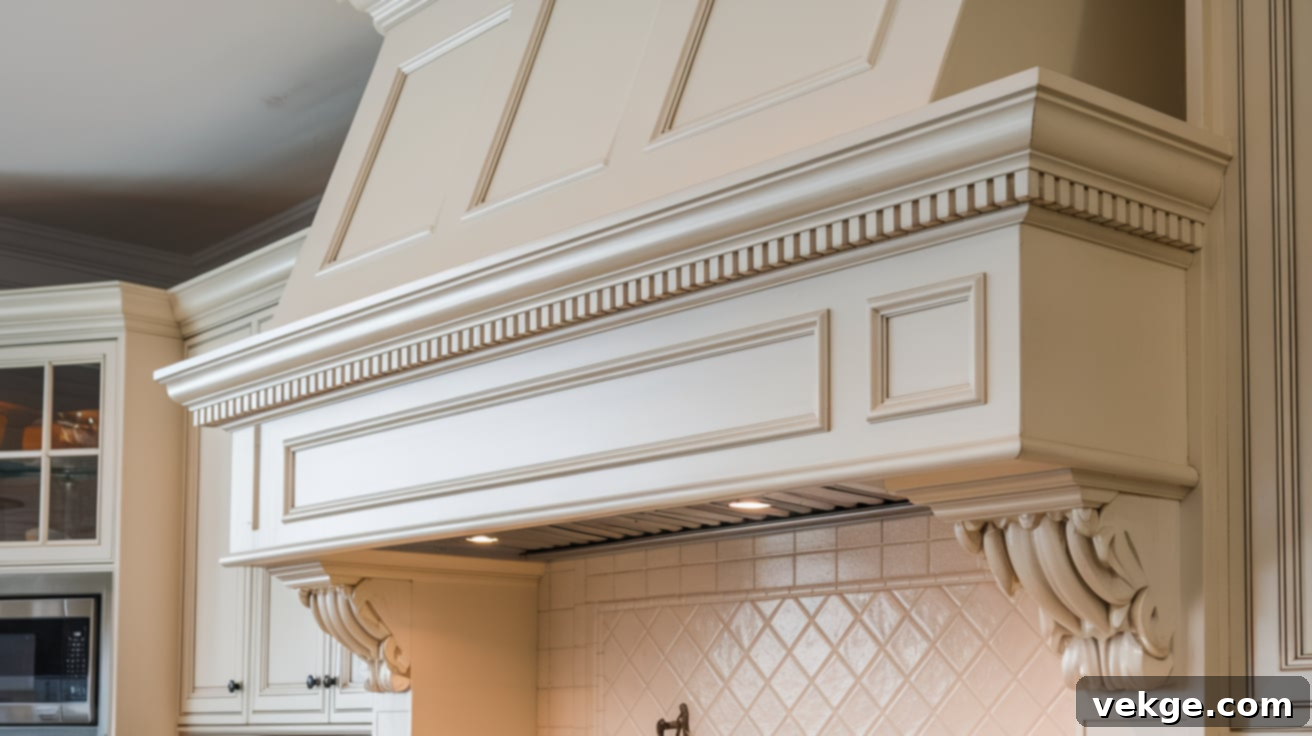
Elevate your range hood cover with the addition of decorative molding. Elements such as classic crown molding, intricate dentil molding, or other detailed trim work introduce significant depth, character, and architectural interest to the space. The right molding choice can meticulously match existing cabinet details, creating a harmonious and cohesive look, or it can stand alone as a special, finely crafted touch that significantly enhances the entire kitchen design, adding a layer of traditional elegance or custom detail.
27. Geometric Patterned Range Hood Cover
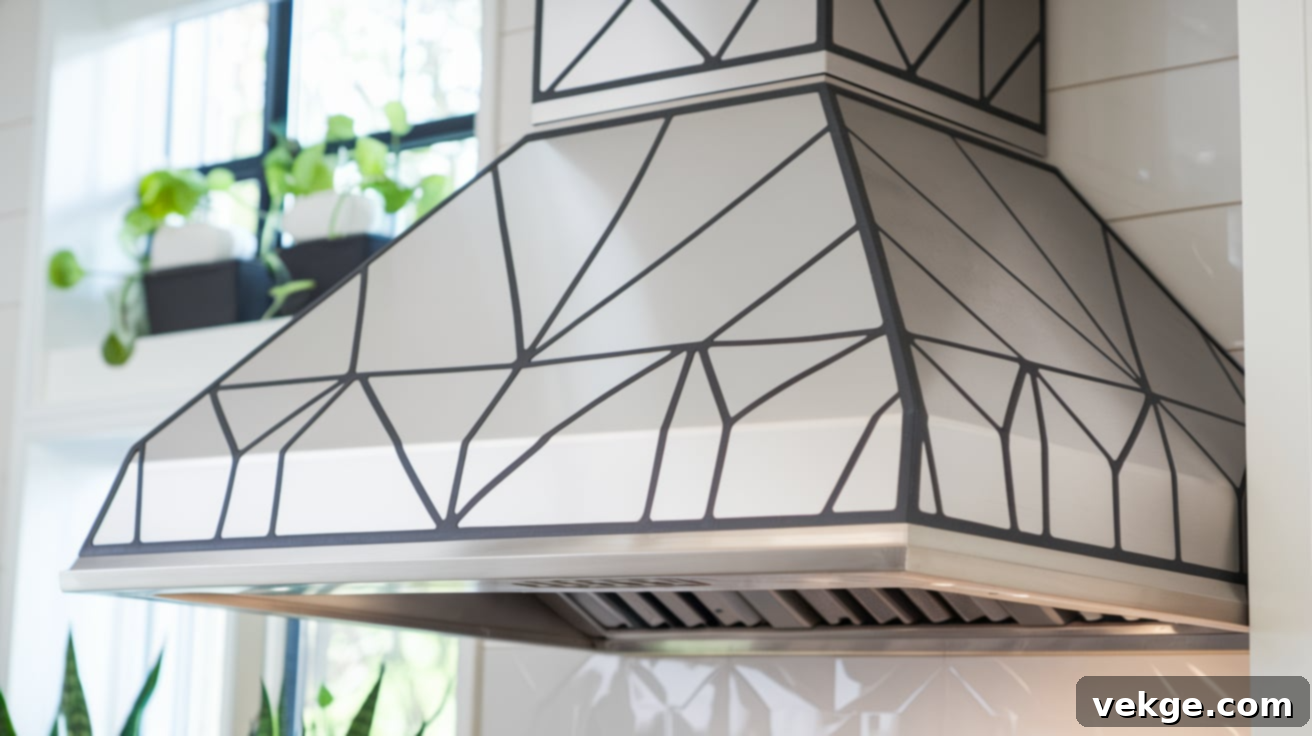
Clean lines and bold, repeating shapes define the geometric patterned range hood cover, creating modern, eye-catching designs. These patterns might feature striking diamonds, contemporary hexagons, or elegant straight-line details, adding a dynamic visual texture. The precise, exact shapes appeal particularly to those who appreciate order, structure, and a sleek aesthetic in their kitchen design, while still allowing for personalized touches and a strong contemporary statement that draws attention.
28. Upcycled Furniture Range Hood Cover
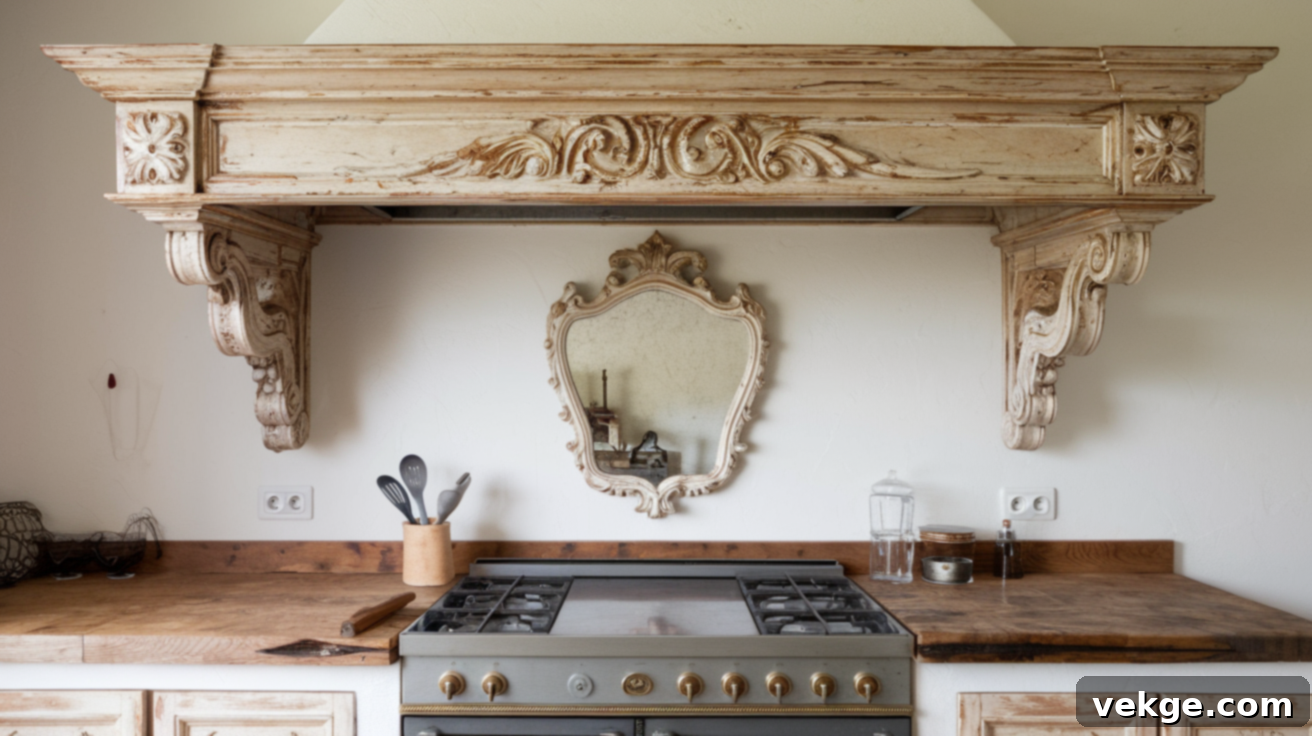
For a truly unique and eco-conscious design, an upcycled furniture range hood cover gives old dresser fronts, headboards, or table parts new life in the kitchen. DIY Danie’s video brilliantly demonstrates how an antique bed frame can be transformed into a one-of-a-kind hood cover (watch the build here: DIY range hood cover from antique bed frame). This creative approach not only adds significant history and character to your kitchen but also benefits both your wallet and the planet through sustainable reuse and repurposing, resulting in a distinctive and meaningful focal point.
29. Cottage-Style Range Hood Cover
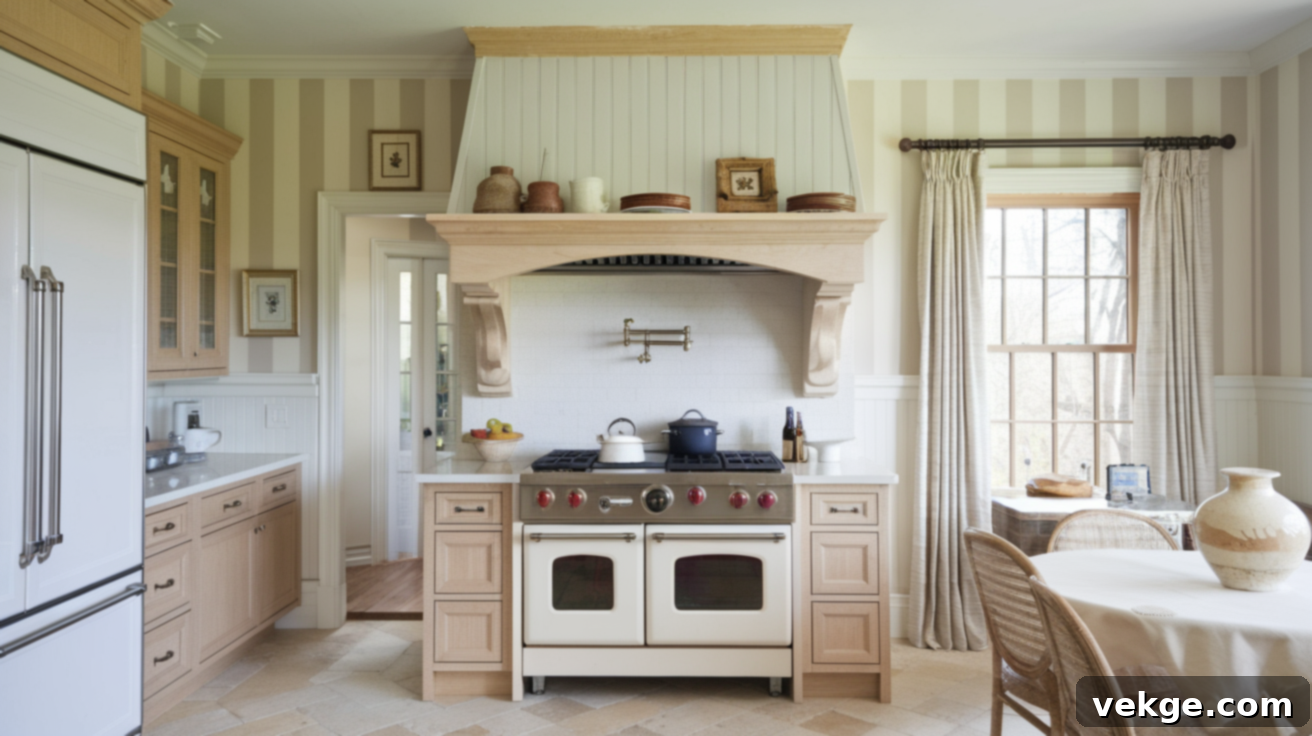
Simple lines and a palette of light, airy colors characterize the inviting cottage-style range hood cover, creating a peaceful and wonderfully lived-in look. Often featuring beadboard or v-groove panels, these covers exude a welcoming and timeless charm. This casual, unassuming style is particularly well-suited for smaller kitchens where an abundance of intricate details might feel overwhelming or visually busy, instead offering a serene and comfortable atmosphere that enhances the sense of home.
30. Rustic Barn Wood Range Hood Cover
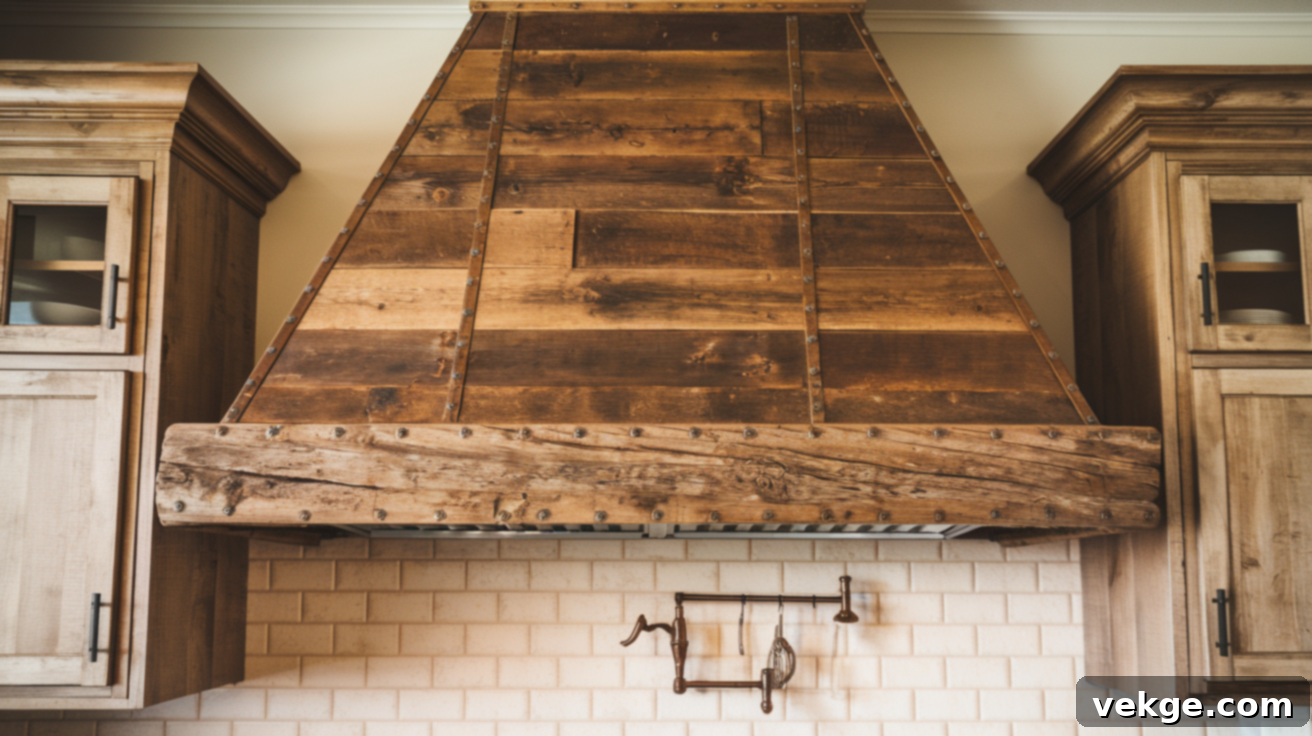
The authentic aged patina of old barn wood brings unparalleled warmth, texture, and a rich history to your kitchen. Each reclaimed board possesses unique color variations, knots, and wear patterns that cannot be replicated through mass production, ensuring your hood cover is truly unique. This distinctive style harmonizes exceptionally well in homes that skillfully blend old and new elements, creating a thoughtfully curated, “gathered-over-time” feel that speaks volumes about character and craftsmanship.
31. Decorative Strapping Range Hood Cover
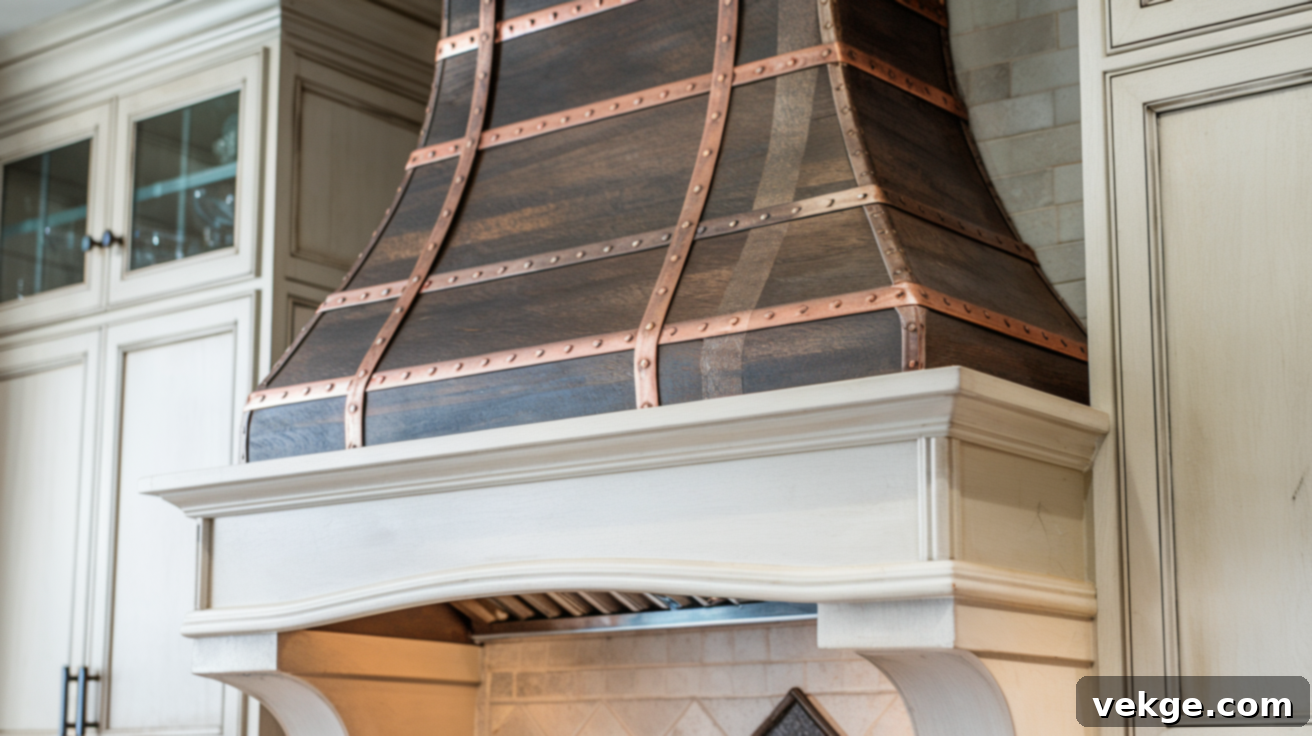
Introduce bold visual interest and captivating contrast with a decorative strapping range hood cover. This design features metal bands strategically wrapped around a wooden base, creating strong linear elements that stand out against softer wood backgrounds. The bands can be crafted from various metals such as warm copper, robust black iron, or sleek brushed nickel, allowing for customization to match your kitchen’s hardware and overall design aesthetic. This style adds a sophisticated and structured touch, perfect for adding architectural detail.
How to Make a Range Hood Cover Yourself (A DIY Guide)
Creating your own custom range hood cover can be an incredibly rewarding project, allowing you to infuse your kitchen with personalized character while also achieving significant cost savings. Drawing insights from the detailed, step-by-step process presented on the “A Drill and a Dream” YouTube channel, here’s a comprehensive guide to building a beautiful wooden range hood cover with a professional finish.
Step 1: Plan Your Dimensions and Build the Frame
Begin by determining the ideal height for your hood, typically positioning it 24-26 inches above your stove for optimal ventilation and ergonomic access. The cover should also be slightly wider than your stove, generally extending 1-2 inches on each side (e.g., a 34-inch wide cover for a 30-inch stove). Next, construct two sturdy wooden rectangles: a larger one for the bottom, matching your planned width, and a slightly smaller one for the top to create an elegant tapered effect. Connect these two frames using angled side boards and incorporate additional support boards between the top and bottom frames to ensure structural stability and rigidity.
Step 2: Mount the Frame and Add the Vent Insert
Carefully locate and mark the wall studs where your range hood cover frame will be securely attached. Using appropriate screws and anchors, mount the frame to the wall, ensuring that it is perfectly level before tightening all fasteners. Within the bottom section of your frame, create a snug inner box or support structure designed specifically to hold your chosen vent hood insert. This provides a solid and secure point for screwing in the insert. Prioritize planning for electrical access and, crucially, test that your vent hood functions correctly before proceeding to the next steps. This ensures all essential components are working as intended.
Step 3: Add Outer Surfaces and Finishing Touches
Once the frame and insert are in place, cut 1/4-inch plywood (or your chosen paneling material) to precisely fit the front and sides of your frame. Secure these panels using small screws or finishing nails, ensuring a seamless fit. Fill any visible gaps, seams, or screw holes with wood filler, then sand smooth for a flawless surface. Now, apply your desired finish: paint for a clean, customized look; stain to highlight natural wood grain; or plaster for a textured, artisanal finish (applying in thin layers and sanding between coats for best results). For a more polished and complete appearance, consider adding decorative molding along the bottom edge of the cover.
For a complete visual demonstration and an even deeper dive into this entire DIY process, we highly recommend checking out the step-by-step tutorial from A Drill & A Dream on their YouTube channel. Their detailed walkthrough provides invaluable visual guidance, helping you confidently visualize each stage before you even pick up your tools. Don’t miss it – check it out here: DIY Custom Wood Range Hood Cover.
Tips for Success: Ensuring a Flawless Range Hood Cover Project
While a custom range hood cover can dramatically enhance your kitchen, many homeowners encounter common pitfalls during the design and installation process. By being aware of these potential challenges beforehand, you can confidently create a hood cover that is both functional and aesthetically pleasing for years to come.
- Verify Ventilation Type: Before starting, confirm whether your existing vent hood is designed for ducted (venting outside) or ductless (recirculating) operation. This critical detail will dictate the necessary allowances within your cover design.
- Plan Ductwork Carefully: If you are installing a ducted system, meticulously plan the route for your ductwork to the outside. Ensure adequate space within the cover for the ducting and any necessary transitions.
- Measure with Precision: Take your time to ensure all measurements are absolutely precise before making any cuts. Measure multiple times and double-check against your plans to avoid costly errors or unsightly gaps.
- Pre-Drill Holes: Always pre-drill pilot holes in wood before driving screws or nails. This prevents the wood from splitting, especially near edges or when working with hardwoods.
- Seek Assistance for Mounting: Mounting the frame to the wall can be challenging and dangerous alone. Always have a helper when lifting and securing the frame to ensure safety and accurate placement.
- Test Functionality Early: Crucially, test the full function of your vent hood insert (power, fan speeds, lights) after it’s installed within the frame but *before* you apply the outer decorative surfaces. This allows for easy troubleshooting if any issues arise.
- Consider Future Maintenance: Think about how you will access filters, motors, or lighting for future cleaning and maintenance. Design your cover with discreet access panels if necessary.
With some fundamental carpentry skills, careful planning, and a dose of patience, you can successfully create a custom range hood cover that appears professionally made and perfectly complements your kitchen’s unique style. This rewarding DIY project can typically be completed over a weekend and offers the potential to save hundreds, if not thousands, of dollars compared to purchasing custom-built, off-the-shelf options.
Conclusion
Range hood covers have truly evolved beyond their purely functional origins to become pivotal design elements in contemporary kitchens. From the warm, inviting appeal of wooden farmhouse styles and the opulent luxury of marble finishes, to the sleek sophistication of industrial metal options and the boundless creativity of DIY custom builds, there is a perfect cover to harmonize with every kitchen style and personal taste.
The right range hood cover does more than just efficiently remove cooking odors and smoke; it acts as a powerful focal point, intricately weaving together all the design elements of your kitchen. When making your selection, it’s essential to balance both aesthetic appeal and practical considerations. Choose materials that not only enhance your decor but also ensure proper sizing, efficient ventilation, and ease of maintenance.
With thoughtful planning and a clear vision, your range hood cover can transcend its utilitarian purpose, becoming one of the most striking and memorable features in your kitchen, reflecting your unique style and enhancing the heart of your home.
Frequently Asked Questions About Range Hood Covers
What materials are best for a range hood cover?
Wood, metal (like stainless steel, copper, or zinc), stone (marble, granite, quartz), and plaster/drywall are among the most popular choices. Wood offers warmth, versatility, and easy customization for painting or staining. Metal provides durability, a modern aesthetic, and is often easy to clean. Stone offers a luxurious, high-end feel but requires professional installation due to weight. The best material depends on your kitchen’s style, your budget, and your preferences for maintenance.
How much does it cost to make or buy a range hood cover?
The cost varies significantly. DIY projects typically range from $40-$300 for raw materials, depending on the wood type, finishes, and complexity. Ready-made covers can start from around $275 for basic, mass-produced models and can escalate to $2,000 or more for high-end, custom-designed options from specialty manufacturers. Factors like material, size, intricate details, and whether it requires professional installation all influence the final price.
Can I make my own range hood cover if I don’t have DIY experience?
Yes, absolutely! With basic tools, patience, and careful adherence to instructions, even beginners can build a range hood cover. Start with simpler designs, such as a basic box shape, and thoroughly follow online tutorials (like those from “A Drill & A Dream” or “DIY Danie”). A “slipcover” style, which fits over an existing, functional hood, is an excellent entry-level project as it primarily focuses on aesthetic cladding rather than complex internal structures. Remember to always prioritize safety and take precise measurements.
How do I clean and maintain my range hood cover?
Maintenance depends entirely on the material. Wooden covers typically require dusting and occasional wiping with a damp cloth and mild wood cleaner; avoid excessive moisture. Metal covers can be cleaned with appropriate metal cleaners or a gentle dish soap solution to prevent streaks. Stone covers often need specific stone cleaners to maintain their finish and avoid etching. Plaster/drywall covers can usually be wiped down with a damp cloth or repainted if scuffed. Always refer to the manufacturer’s recommendations for any finished products or specific material care instructions.
